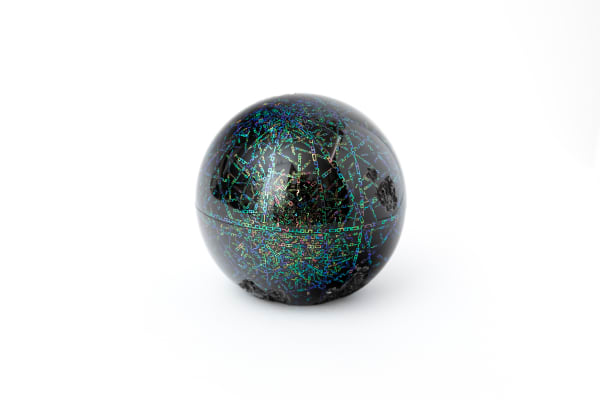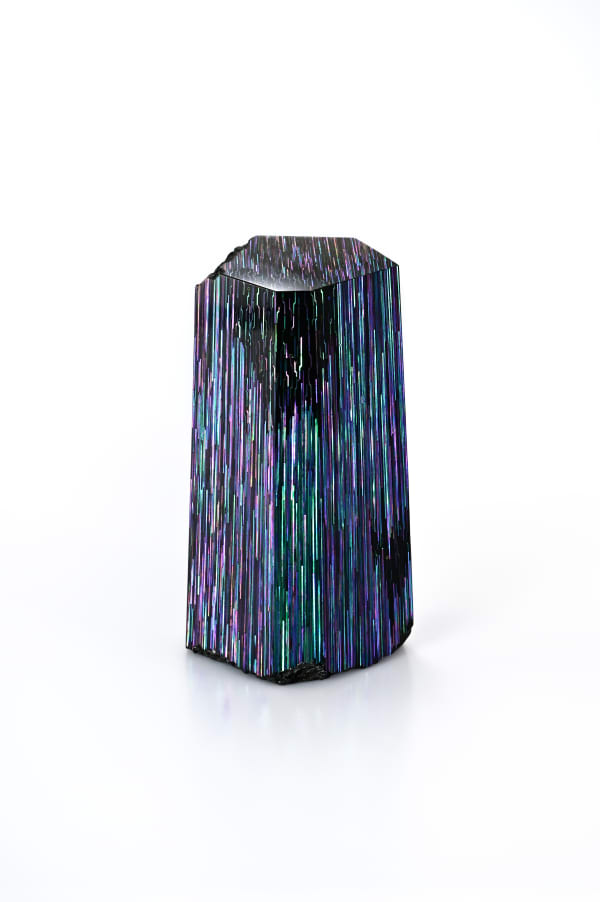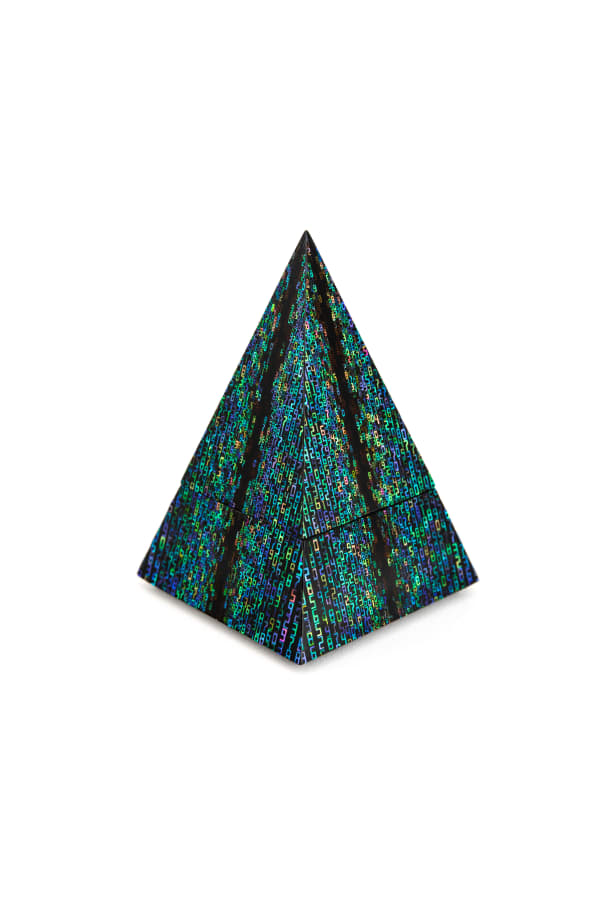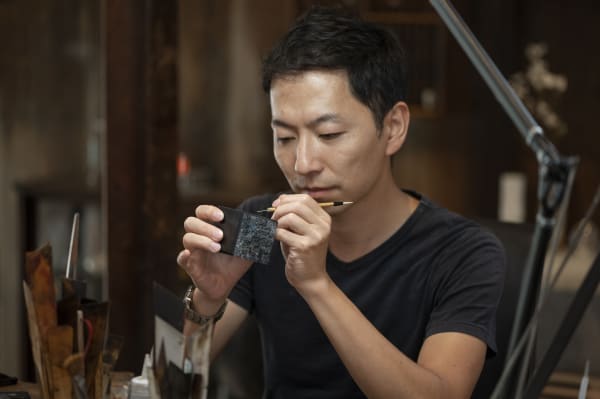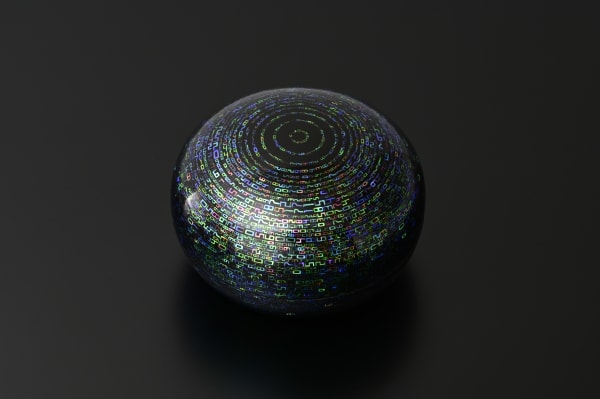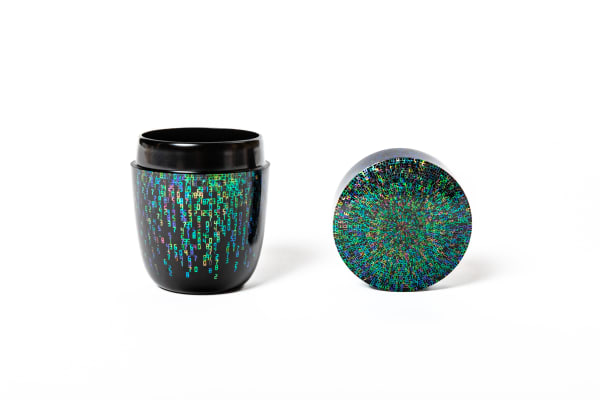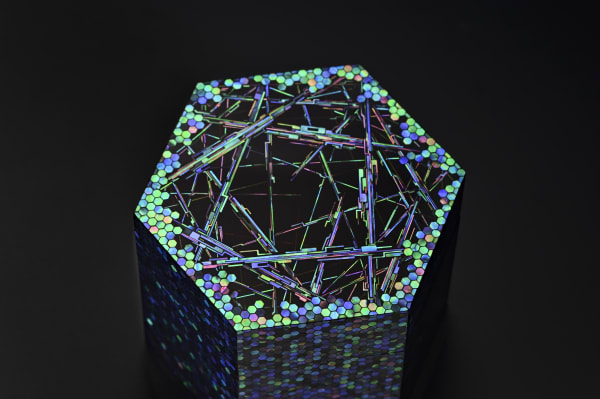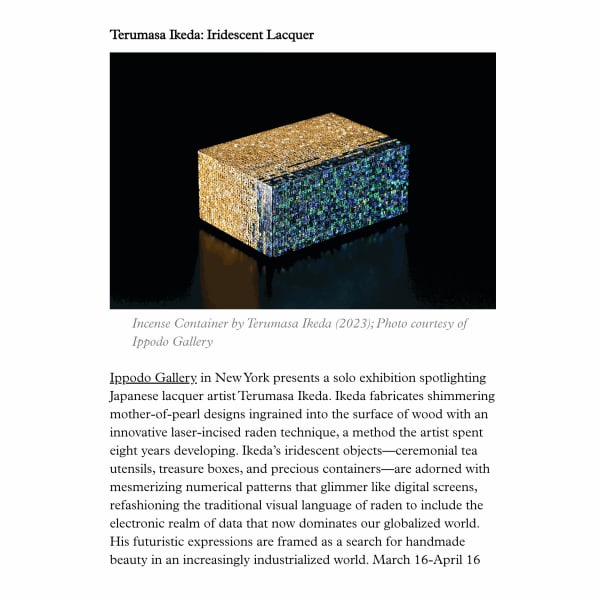-
Overview
 Terumasa Ikeda”Throne" Incense Container - 百千玉璽香合, 2023Urushi Lacquer, Cypress, Mother-of-Pearl, Turbo Snail Pearl, GoldH4 x W4 x D4 cm
Terumasa Ikeda”Throne" Incense Container - 百千玉璽香合, 2023Urushi Lacquer, Cypress, Mother-of-Pearl, Turbo Snail Pearl, GoldH4 x W4 x D4 cm
H1.57 x W1.57 x D1.57 inIppodo Gallery New York illuminates a modern lacquer technique that disrupts preconceived notions of the raden (mother-of -pearl inlay) tradition. Terumasa Ikeda: Iridescent Lacquer—on display from March 16th to April 20th, 2023—showcases Terumasa Ikeda’s revolutionary laser-incised raden technique, a method the artist spent eight years developing. Ikeda was born and resides in Kanazawa, known as the country’s preeminent hub for lacquerware production. Arabic numerals, computer screens, and digital signals—all assembled from abalone shell—adorn the twenty object boxes, tea caddies, and incense containers.
In various sizes, from cubes to hexagons to pyramids, Ikeda’s artworks are crafted from most precious materials: a base of Japanese native kiso hinoki wood is coated with innumerable layers of black urushi lacquer and decorated with gold leaf, gold powder, and mother-of-pearl. With a hand in each step of the fabrication, the pristine forms cut from wood and varnished with urushi lacquer perfectly accentuate the miniscule and intricate decorations of Ikeda’s design.
The truly unique interpretation of the rare technique has made Terumasa Ikeda one of the most sought after raden artists of the new generation. For Ikeda, this technique is a most natural progression in keeping with the times; where once raden was dominated by images of the divine, Ikeda’s cutting-edge artworks assert that magic—really, the laws and values of our modern society—is one to nine and everything in between.
Be sure to read Ippodo's journal, published weekly, including an upcoming feature on Terumasa Ikeda’s March exhibition. The artist will attend a forthcoming reception hosted by Ippodo Gallery at 32 E 67th Street to discuss his work and answer questions. All are welcome.
Share- X
- Tumblr
-
Works
-
 Terumasa Ikeda百千航路図珠箱 - “Course” Ornamental Box, 2023Urushi Laquer, Cypress, Mother-of-Pearl, Gold%3Cdiv%20class%3D%22artist%22%3ETerumasa%20Ikeda%3C/div%3E%3Cdiv%20class%3D%22title_and_year%22%3E%3Cspan%20class%3D%22title_and_year_title%22%3E%E7%99%BE%E5%8D%83%E8%88%AA%E8%B7%AF%E5%9B%B3%E7%8F%A0%E7%AE%B1%20-%20%E2%80%9CCourse%E2%80%9D%20Ornamental%20Box%3C/span%3E%3Cspan%20class%3D%22comma%22%3E%2C%20%3C/span%3E%3Cspan%20class%3D%22title_and_year_year%22%3E2023%3C/span%3E%3C/div%3E%3Cdiv%20class%3D%22medium%22%3EUrushi%20Laquer%3Cspan%20class%3D%22comma%22%3E%2C%20%3C/span%3ECypress%3Cspan%20class%3D%22comma%22%3E%2C%20%3C/span%3EMother-of-Pearl%3Cspan%20class%3D%22comma%22%3E%2C%20%3C/span%3EGold%3C/div%3E
Terumasa Ikeda百千航路図珠箱 - “Course” Ornamental Box, 2023Urushi Laquer, Cypress, Mother-of-Pearl, Gold%3Cdiv%20class%3D%22artist%22%3ETerumasa%20Ikeda%3C/div%3E%3Cdiv%20class%3D%22title_and_year%22%3E%3Cspan%20class%3D%22title_and_year_title%22%3E%E7%99%BE%E5%8D%83%E8%88%AA%E8%B7%AF%E5%9B%B3%E7%8F%A0%E7%AE%B1%20-%20%E2%80%9CCourse%E2%80%9D%20Ornamental%20Box%3C/span%3E%3Cspan%20class%3D%22comma%22%3E%2C%20%3C/span%3E%3Cspan%20class%3D%22title_and_year_year%22%3E2023%3C/span%3E%3C/div%3E%3Cdiv%20class%3D%22medium%22%3EUrushi%20Laquer%3Cspan%20class%3D%22comma%22%3E%2C%20%3C/span%3ECypress%3Cspan%20class%3D%22comma%22%3E%2C%20%3C/span%3EMother-of-Pearl%3Cspan%20class%3D%22comma%22%3E%2C%20%3C/span%3EGold%3C/div%3E
-
 Terumasa Ikeda”Throne" Incense Container - 百千玉璽香合, 2023Urushi Lacquer, Cypress, Mother-of-Pearl, Turbo Snail Pearl, Gold%3Cdiv%20class%3D%22artist%22%3ETerumasa%20Ikeda%3C/div%3E%3Cdiv%20class%3D%22title_and_year%22%3E%3Cspan%20class%3D%22title_and_year_title%22%3E%E2%80%9DThrone%22%20Incense%20Container%20-%20%E7%99%BE%E5%8D%83%E7%8E%89%E7%92%BD%E9%A6%99%E5%90%88%3C/span%3E%3Cspan%20class%3D%22comma%22%3E%2C%20%3C/span%3E%3Cspan%20class%3D%22title_and_year_year%22%3E2023%3C/span%3E%3C/div%3E%3Cdiv%20class%3D%22medium%22%3EUrushi%20Lacquer%3Cspan%20class%3D%22comma%22%3E%2C%20%3C/span%3ECypress%3Cspan%20class%3D%22comma%22%3E%2C%20%3C/span%3EMother-of-Pearl%3Cspan%20class%3D%22comma%22%3E%2C%20%3C/span%3ETurbo%20Snail%20Pearl%3Cspan%20class%3D%22comma%22%3E%2C%20%3C/span%3EGold%3C/div%3E
Terumasa Ikeda”Throne" Incense Container - 百千玉璽香合, 2023Urushi Lacquer, Cypress, Mother-of-Pearl, Turbo Snail Pearl, Gold%3Cdiv%20class%3D%22artist%22%3ETerumasa%20Ikeda%3C/div%3E%3Cdiv%20class%3D%22title_and_year%22%3E%3Cspan%20class%3D%22title_and_year_title%22%3E%E2%80%9DThrone%22%20Incense%20Container%20-%20%E7%99%BE%E5%8D%83%E7%8E%89%E7%92%BD%E9%A6%99%E5%90%88%3C/span%3E%3Cspan%20class%3D%22comma%22%3E%2C%20%3C/span%3E%3Cspan%20class%3D%22title_and_year_year%22%3E2023%3C/span%3E%3C/div%3E%3Cdiv%20class%3D%22medium%22%3EUrushi%20Lacquer%3Cspan%20class%3D%22comma%22%3E%2C%20%3C/span%3ECypress%3Cspan%20class%3D%22comma%22%3E%2C%20%3C/span%3EMother-of-Pearl%3Cspan%20class%3D%22comma%22%3E%2C%20%3C/span%3ETurbo%20Snail%20Pearl%3Cspan%20class%3D%22comma%22%3E%2C%20%3C/span%3EGold%3C/div%3E
-
 Terumasa Ikeda"Accelerator" Incense Container - 八方百千加速香合, 2023Urushi Lacquer, Cypress, Mother-of-Pearl, Turbo Snail%3Cdiv%20class%3D%22artist%22%3ETerumasa%20Ikeda%3C/div%3E%3Cdiv%20class%3D%22title_and_year%22%3E%3Cspan%20class%3D%22title_and_year_title%22%3E%22Accelerator%22%20Incense%20Container%20-%20%E5%85%AB%E6%96%B9%E7%99%BE%E5%8D%83%E5%8A%A0%E9%80%9F%E9%A6%99%E5%90%88%3C/span%3E%3Cspan%20class%3D%22comma%22%3E%2C%20%3C/span%3E%3Cspan%20class%3D%22title_and_year_year%22%3E2023%3C/span%3E%3C/div%3E%3Cdiv%20class%3D%22medium%22%3EUrushi%20Lacquer%3Cspan%20class%3D%22comma%22%3E%2C%20%3C/span%3ECypress%3Cspan%20class%3D%22comma%22%3E%2C%20%3C/span%3EMother-of-Pearl%3Cspan%20class%3D%22comma%22%3E%2C%20%3C/span%3ETurbo%20Snail%3C/div%3E
Terumasa Ikeda"Accelerator" Incense Container - 八方百千加速香合, 2023Urushi Lacquer, Cypress, Mother-of-Pearl, Turbo Snail%3Cdiv%20class%3D%22artist%22%3ETerumasa%20Ikeda%3C/div%3E%3Cdiv%20class%3D%22title_and_year%22%3E%3Cspan%20class%3D%22title_and_year_title%22%3E%22Accelerator%22%20Incense%20Container%20-%20%E5%85%AB%E6%96%B9%E7%99%BE%E5%8D%83%E5%8A%A0%E9%80%9F%E9%A6%99%E5%90%88%3C/span%3E%3Cspan%20class%3D%22comma%22%3E%2C%20%3C/span%3E%3Cspan%20class%3D%22title_and_year_year%22%3E2023%3C/span%3E%3C/div%3E%3Cdiv%20class%3D%22medium%22%3EUrushi%20Lacquer%3Cspan%20class%3D%22comma%22%3E%2C%20%3C/span%3ECypress%3Cspan%20class%3D%22comma%22%3E%2C%20%3C/span%3EMother-of-Pearl%3Cspan%20class%3D%22comma%22%3E%2C%20%3C/span%3ETurbo%20Snail%3C/div%3E
-
 Terumasa Ikeda"Data Tunnel” Pentagonal Tea Caddy - 電光五角中次, 2023Urushi Lacquer, Cypress, Mother-of-Pearl, Turbo Snail Pearl%3Cdiv%20class%3D%22artist%22%3ETerumasa%20Ikeda%3C/div%3E%3Cdiv%20class%3D%22title_and_year%22%3E%3Cspan%20class%3D%22title_and_year_title%22%3E%22Data%20Tunnel%E2%80%9D%20Pentagonal%20Tea%20Caddy%20-%20%E9%9B%BB%E5%85%89%E4%BA%94%E8%A7%92%E4%B8%AD%E6%AC%A1%3C/span%3E%3Cspan%20class%3D%22comma%22%3E%2C%20%3C/span%3E%3Cspan%20class%3D%22title_and_year_year%22%3E2023%3C/span%3E%3C/div%3E%3Cdiv%20class%3D%22medium%22%3EUrushi%20Lacquer%3Cspan%20class%3D%22comma%22%3E%2C%20%3C/span%3ECypress%3Cspan%20class%3D%22comma%22%3E%2C%20%3C/span%3EMother-of-Pearl%3Cspan%20class%3D%22comma%22%3E%2C%20%3C/span%3ETurbo%20Snail%20Pearl%3C/div%3E
Terumasa Ikeda"Data Tunnel” Pentagonal Tea Caddy - 電光五角中次, 2023Urushi Lacquer, Cypress, Mother-of-Pearl, Turbo Snail Pearl%3Cdiv%20class%3D%22artist%22%3ETerumasa%20Ikeda%3C/div%3E%3Cdiv%20class%3D%22title_and_year%22%3E%3Cspan%20class%3D%22title_and_year_title%22%3E%22Data%20Tunnel%E2%80%9D%20Pentagonal%20Tea%20Caddy%20-%20%E9%9B%BB%E5%85%89%E4%BA%94%E8%A7%92%E4%B8%AD%E6%AC%A1%3C/span%3E%3Cspan%20class%3D%22comma%22%3E%2C%20%3C/span%3E%3Cspan%20class%3D%22title_and_year_year%22%3E2023%3C/span%3E%3C/div%3E%3Cdiv%20class%3D%22medium%22%3EUrushi%20Lacquer%3Cspan%20class%3D%22comma%22%3E%2C%20%3C/span%3ECypress%3Cspan%20class%3D%22comma%22%3E%2C%20%3C/span%3EMother-of-Pearl%3Cspan%20class%3D%22comma%22%3E%2C%20%3C/span%3ETurbo%20Snail%20Pearl%3C/div%3E
-
 Terumasa Ikeda“Blue Beryl” Tea Caddy - 青螺石中次, 2023Urushi Laquer, Cypress, Mother-of-Pearl, Turbo Snail Pearl%3Cdiv%20class%3D%22artist%22%3ETerumasa%20Ikeda%3C/div%3E%3Cdiv%20class%3D%22title_and_year%22%3E%3Cspan%20class%3D%22title_and_year_title%22%3E%E2%80%9CBlue%20Beryl%E2%80%9D%20Tea%20Caddy%20-%20%E9%9D%92%E8%9E%BA%E7%9F%B3%E4%B8%AD%E6%AC%A1%3C/span%3E%3Cspan%20class%3D%22comma%22%3E%2C%20%3C/span%3E%3Cspan%20class%3D%22title_and_year_year%22%3E2023%3C/span%3E%3C/div%3E%3Cdiv%20class%3D%22medium%22%3EUrushi%20Laquer%3Cspan%20class%3D%22comma%22%3E%2C%20%3C/span%3ECypress%3Cspan%20class%3D%22comma%22%3E%2C%20%3C/span%3EMother-of-Pearl%3Cspan%20class%3D%22comma%22%3E%2C%20%3C/span%3ETurbo%20Snail%20Pearl%3C/div%3E
Terumasa Ikeda“Blue Beryl” Tea Caddy - 青螺石中次, 2023Urushi Laquer, Cypress, Mother-of-Pearl, Turbo Snail Pearl%3Cdiv%20class%3D%22artist%22%3ETerumasa%20Ikeda%3C/div%3E%3Cdiv%20class%3D%22title_and_year%22%3E%3Cspan%20class%3D%22title_and_year_title%22%3E%E2%80%9CBlue%20Beryl%E2%80%9D%20Tea%20Caddy%20-%20%E9%9D%92%E8%9E%BA%E7%9F%B3%E4%B8%AD%E6%AC%A1%3C/span%3E%3Cspan%20class%3D%22comma%22%3E%2C%20%3C/span%3E%3Cspan%20class%3D%22title_and_year_year%22%3E2023%3C/span%3E%3C/div%3E%3Cdiv%20class%3D%22medium%22%3EUrushi%20Laquer%3Cspan%20class%3D%22comma%22%3E%2C%20%3C/span%3ECypress%3Cspan%20class%3D%22comma%22%3E%2C%20%3C/span%3EMother-of-Pearl%3Cspan%20class%3D%22comma%22%3E%2C%20%3C/span%3ETurbo%20Snail%20Pearl%3C/div%3E
-
 Terumasa IkedaError-Order- , 2023Urushi Lacquer, Cypress, Mother-of-Pearl, Turbo Snail Pearl%3Cdiv%20class%3D%22artist%22%3ETerumasa%20Ikeda%3C/div%3E%3Cdiv%20class%3D%22title_and_year%22%3E%3Cspan%20class%3D%22title_and_year_title%22%3EError-Order-%20%3C/span%3E%3Cspan%20class%3D%22comma%22%3E%2C%20%3C/span%3E%3Cspan%20class%3D%22title_and_year_year%22%3E2023%3C/span%3E%3C/div%3E%3Cdiv%20class%3D%22medium%22%3EUrushi%20Lacquer%3Cspan%20class%3D%22comma%22%3E%2C%20%3C/span%3ECypress%3Cspan%20class%3D%22comma%22%3E%2C%20%3C/span%3EMother-of-Pearl%3Cspan%20class%3D%22comma%22%3E%2C%20%3C/span%3ETurbo%20Snail%20Pearl%3C/div%3E
Terumasa IkedaError-Order- , 2023Urushi Lacquer, Cypress, Mother-of-Pearl, Turbo Snail Pearl%3Cdiv%20class%3D%22artist%22%3ETerumasa%20Ikeda%3C/div%3E%3Cdiv%20class%3D%22title_and_year%22%3E%3Cspan%20class%3D%22title_and_year_title%22%3EError-Order-%20%3C/span%3E%3Cspan%20class%3D%22comma%22%3E%2C%20%3C/span%3E%3Cspan%20class%3D%22title_and_year_year%22%3E2023%3C/span%3E%3C/div%3E%3Cdiv%20class%3D%22medium%22%3EUrushi%20Lacquer%3Cspan%20class%3D%22comma%22%3E%2C%20%3C/span%3ECypress%3Cspan%20class%3D%22comma%22%3E%2C%20%3C/span%3EMother-of-Pearl%3Cspan%20class%3D%22comma%22%3E%2C%20%3C/span%3ETurbo%20Snail%20Pearl%3C/div%3E
-
 Terumasa Ikeda"Lightning Effect" Fubuki Style Tea Caddy - 夜光紫電雪吹, 2023Urushi Laquer, Cypress, Mother-of-Pearl, Turbo Snail Pearl%3Cdiv%20class%3D%22artist%22%3ETerumasa%20Ikeda%3C/div%3E%3Cdiv%20class%3D%22title_and_year%22%3E%3Cspan%20class%3D%22title_and_year_title%22%3E%22Lightning%20Effect%22%20Fubuki%20Style%20Tea%20Caddy%20-%20%E5%A4%9C%E5%85%89%E7%B4%AB%E9%9B%BB%E9%9B%AA%E5%90%B9%3C/span%3E%3Cspan%20class%3D%22comma%22%3E%2C%20%3C/span%3E%3Cspan%20class%3D%22title_and_year_year%22%3E2023%3C/span%3E%3C/div%3E%3Cdiv%20class%3D%22medium%22%3EUrushi%20Laquer%3Cspan%20class%3D%22comma%22%3E%2C%20%3C/span%3ECypress%3Cspan%20class%3D%22comma%22%3E%2C%20%3C/span%3EMother-of-Pearl%3Cspan%20class%3D%22comma%22%3E%2C%20%3C/span%3ETurbo%20Snail%20Pearl%3C/div%3E
Terumasa Ikeda"Lightning Effect" Fubuki Style Tea Caddy - 夜光紫電雪吹, 2023Urushi Laquer, Cypress, Mother-of-Pearl, Turbo Snail Pearl%3Cdiv%20class%3D%22artist%22%3ETerumasa%20Ikeda%3C/div%3E%3Cdiv%20class%3D%22title_and_year%22%3E%3Cspan%20class%3D%22title_and_year_title%22%3E%22Lightning%20Effect%22%20Fubuki%20Style%20Tea%20Caddy%20-%20%E5%A4%9C%E5%85%89%E7%B4%AB%E9%9B%BB%E9%9B%AA%E5%90%B9%3C/span%3E%3Cspan%20class%3D%22comma%22%3E%2C%20%3C/span%3E%3Cspan%20class%3D%22title_and_year_year%22%3E2023%3C/span%3E%3C/div%3E%3Cdiv%20class%3D%22medium%22%3EUrushi%20Laquer%3Cspan%20class%3D%22comma%22%3E%2C%20%3C/span%3ECypress%3Cspan%20class%3D%22comma%22%3E%2C%20%3C/span%3EMother-of-Pearl%3Cspan%20class%3D%22comma%22%3E%2C%20%3C/span%3ETurbo%20Snail%20Pearl%3C/div%3E
-
 Terumasa Ikeda"Noise 01" Fubuki Style Tea Caddy - 光絵素乱調雪吹其壱, 2023Urushi Laquer, Cypress, Turbo Snail Pearl%3Cdiv%20class%3D%22artist%22%3ETerumasa%20Ikeda%3C/div%3E%3Cdiv%20class%3D%22title_and_year%22%3E%3Cspan%20class%3D%22title_and_year_title%22%3E%22Noise%2001%22%20Fubuki%20Style%20Tea%20Caddy%20-%20%E5%85%89%E7%B5%B5%E7%B4%A0%E4%B9%B1%E8%AA%BF%E9%9B%AA%E5%90%B9%E5%85%B6%E5%A3%B1%3C/span%3E%3Cspan%20class%3D%22comma%22%3E%2C%20%3C/span%3E%3Cspan%20class%3D%22title_and_year_year%22%3E2023%3C/span%3E%3C/div%3E%3Cdiv%20class%3D%22medium%22%3EUrushi%20Laquer%3Cspan%20class%3D%22comma%22%3E%2C%20%3C/span%3ECypress%3Cspan%20class%3D%22comma%22%3E%2C%20%3C/span%3ETurbo%20Snail%20Pearl%3C/div%3E
Terumasa Ikeda"Noise 01" Fubuki Style Tea Caddy - 光絵素乱調雪吹其壱, 2023Urushi Laquer, Cypress, Turbo Snail Pearl%3Cdiv%20class%3D%22artist%22%3ETerumasa%20Ikeda%3C/div%3E%3Cdiv%20class%3D%22title_and_year%22%3E%3Cspan%20class%3D%22title_and_year_title%22%3E%22Noise%2001%22%20Fubuki%20Style%20Tea%20Caddy%20-%20%E5%85%89%E7%B5%B5%E7%B4%A0%E4%B9%B1%E8%AA%BF%E9%9B%AA%E5%90%B9%E5%85%B6%E5%A3%B1%3C/span%3E%3Cspan%20class%3D%22comma%22%3E%2C%20%3C/span%3E%3Cspan%20class%3D%22title_and_year_year%22%3E2023%3C/span%3E%3C/div%3E%3Cdiv%20class%3D%22medium%22%3EUrushi%20Laquer%3Cspan%20class%3D%22comma%22%3E%2C%20%3C/span%3ECypress%3Cspan%20class%3D%22comma%22%3E%2C%20%3C/span%3ETurbo%20Snail%20Pearl%3C/div%3E
-
 Terumasa Ikeda"Decimal" Incense Container - 百千寸五香合, 2023Laquer, Cypress, Mother-of-Pearl, Gold%3Cdiv%20class%3D%22artist%22%3ETerumasa%20Ikeda%3C/div%3E%3Cdiv%20class%3D%22title_and_year%22%3E%3Cspan%20class%3D%22title_and_year_title%22%3E%22Decimal%22%20Incense%20Container%20-%20%E7%99%BE%E5%8D%83%E5%AF%B8%E4%BA%94%E9%A6%99%E5%90%88%3C/span%3E%3Cspan%20class%3D%22comma%22%3E%2C%20%3C/span%3E%3Cspan%20class%3D%22title_and_year_year%22%3E2023%3C/span%3E%3C/div%3E%3Cdiv%20class%3D%22medium%22%3ELaquer%3Cspan%20class%3D%22comma%22%3E%2C%20%3C/span%3ECypress%3Cspan%20class%3D%22comma%22%3E%2C%20%3C/span%3EMother-of-Pearl%3Cspan%20class%3D%22comma%22%3E%2C%20%3C/span%3EGold%3C/div%3E
Terumasa Ikeda"Decimal" Incense Container - 百千寸五香合, 2023Laquer, Cypress, Mother-of-Pearl, Gold%3Cdiv%20class%3D%22artist%22%3ETerumasa%20Ikeda%3C/div%3E%3Cdiv%20class%3D%22title_and_year%22%3E%3Cspan%20class%3D%22title_and_year_title%22%3E%22Decimal%22%20Incense%20Container%20-%20%E7%99%BE%E5%8D%83%E5%AF%B8%E4%BA%94%E9%A6%99%E5%90%88%3C/span%3E%3Cspan%20class%3D%22comma%22%3E%2C%20%3C/span%3E%3Cspan%20class%3D%22title_and_year_year%22%3E2023%3C/span%3E%3C/div%3E%3Cdiv%20class%3D%22medium%22%3ELaquer%3Cspan%20class%3D%22comma%22%3E%2C%20%3C/span%3ECypress%3Cspan%20class%3D%22comma%22%3E%2C%20%3C/span%3EMother-of-Pearl%3Cspan%20class%3D%22comma%22%3E%2C%20%3C/span%3EGold%3C/div%3E
-
 Terumasa Ikeda"Beginnings" Pyramidal Incense Container - 百千開闢金字塔香合, 2023Urushi Lacquer, Cypress, Mother-of-Pearl, Turbo Snail Pearl, Silver Lip Oyster, Gold%3Cdiv%20class%3D%22artist%22%3ETerumasa%20Ikeda%3C/div%3E%3Cdiv%20class%3D%22title_and_year%22%3E%3Cspan%20class%3D%22title_and_year_title%22%3E%22Beginnings%22%20Pyramidal%20Incense%20Container%20-%20%E7%99%BE%E5%8D%83%E9%96%8B%E9%97%A2%E9%87%91%E5%AD%97%E5%A1%94%E9%A6%99%E5%90%88%3C/span%3E%3Cspan%20class%3D%22comma%22%3E%2C%20%3C/span%3E%3Cspan%20class%3D%22title_and_year_year%22%3E2023%3C/span%3E%3C/div%3E%3Cdiv%20class%3D%22medium%22%3EUrushi%20Lacquer%3Cspan%20class%3D%22comma%22%3E%2C%20%3C/span%3ECypress%3Cspan%20class%3D%22comma%22%3E%2C%20%3C/span%3EMother-of-Pearl%3Cspan%20class%3D%22comma%22%3E%2C%20%3C/span%3ETurbo%20Snail%20Pearl%3Cspan%20class%3D%22comma%22%3E%2C%20%3C/span%3ESilver%20Lip%20Oyster%3Cspan%20class%3D%22comma%22%3E%2C%20%3C/span%3EGold%3C/div%3E
Terumasa Ikeda"Beginnings" Pyramidal Incense Container - 百千開闢金字塔香合, 2023Urushi Lacquer, Cypress, Mother-of-Pearl, Turbo Snail Pearl, Silver Lip Oyster, Gold%3Cdiv%20class%3D%22artist%22%3ETerumasa%20Ikeda%3C/div%3E%3Cdiv%20class%3D%22title_and_year%22%3E%3Cspan%20class%3D%22title_and_year_title%22%3E%22Beginnings%22%20Pyramidal%20Incense%20Container%20-%20%E7%99%BE%E5%8D%83%E9%96%8B%E9%97%A2%E9%87%91%E5%AD%97%E5%A1%94%E9%A6%99%E5%90%88%3C/span%3E%3Cspan%20class%3D%22comma%22%3E%2C%20%3C/span%3E%3Cspan%20class%3D%22title_and_year_year%22%3E2023%3C/span%3E%3C/div%3E%3Cdiv%20class%3D%22medium%22%3EUrushi%20Lacquer%3Cspan%20class%3D%22comma%22%3E%2C%20%3C/span%3ECypress%3Cspan%20class%3D%22comma%22%3E%2C%20%3C/span%3EMother-of-Pearl%3Cspan%20class%3D%22comma%22%3E%2C%20%3C/span%3ETurbo%20Snail%20Pearl%3Cspan%20class%3D%22comma%22%3E%2C%20%3C/span%3ESilver%20Lip%20Oyster%3Cspan%20class%3D%22comma%22%3E%2C%20%3C/span%3EGold%3C/div%3E
-
 Terumasa Ikeda"Shore" Incense Container - 百千金砂渚香合, 2023Urushi Lacquer, Cypress, Mother-of-Pearl, Turbo Snail Pearl, Silver Lip Oyster, Gold%3Cdiv%20class%3D%22artist%22%3ETerumasa%20Ikeda%3C/div%3E%3Cdiv%20class%3D%22title_and_year%22%3E%3Cspan%20class%3D%22title_and_year_title%22%3E%22Shore%22%20Incense%20Container%20-%20%E7%99%BE%E5%8D%83%E9%87%91%E7%A0%82%E6%B8%9A%E9%A6%99%E5%90%88%3C/span%3E%3Cspan%20class%3D%22comma%22%3E%2C%20%3C/span%3E%3Cspan%20class%3D%22title_and_year_year%22%3E2023%3C/span%3E%3C/div%3E%3Cdiv%20class%3D%22medium%22%3EUrushi%20Lacquer%3Cspan%20class%3D%22comma%22%3E%2C%20%3C/span%3ECypress%3Cspan%20class%3D%22comma%22%3E%2C%20%3C/span%3EMother-of-Pearl%3Cspan%20class%3D%22comma%22%3E%2C%20%3C/span%3ETurbo%20Snail%20Pearl%3Cspan%20class%3D%22comma%22%3E%2C%20%3C/span%3ESilver%20Lip%20Oyster%3Cspan%20class%3D%22comma%22%3E%2C%20%3C/span%3EGold%3C/div%3E
Terumasa Ikeda"Shore" Incense Container - 百千金砂渚香合, 2023Urushi Lacquer, Cypress, Mother-of-Pearl, Turbo Snail Pearl, Silver Lip Oyster, Gold%3Cdiv%20class%3D%22artist%22%3ETerumasa%20Ikeda%3C/div%3E%3Cdiv%20class%3D%22title_and_year%22%3E%3Cspan%20class%3D%22title_and_year_title%22%3E%22Shore%22%20Incense%20Container%20-%20%E7%99%BE%E5%8D%83%E9%87%91%E7%A0%82%E6%B8%9A%E9%A6%99%E5%90%88%3C/span%3E%3Cspan%20class%3D%22comma%22%3E%2C%20%3C/span%3E%3Cspan%20class%3D%22title_and_year_year%22%3E2023%3C/span%3E%3C/div%3E%3Cdiv%20class%3D%22medium%22%3EUrushi%20Lacquer%3Cspan%20class%3D%22comma%22%3E%2C%20%3C/span%3ECypress%3Cspan%20class%3D%22comma%22%3E%2C%20%3C/span%3EMother-of-Pearl%3Cspan%20class%3D%22comma%22%3E%2C%20%3C/span%3ETurbo%20Snail%20Pearl%3Cspan%20class%3D%22comma%22%3E%2C%20%3C/span%3ESilver%20Lip%20Oyster%3Cspan%20class%3D%22comma%22%3E%2C%20%3C/span%3EGold%3C/div%3E
-
 Terumasa Ikeda"Ice Floe" Incense Container - 百千流氷香合, 2023Urushi Lacquer, Cypress, Mother-of-Pearl, Turbo Snail Pearl, Gold%3Cdiv%20class%3D%22artist%22%3ETerumasa%20Ikeda%3C/div%3E%3Cdiv%20class%3D%22title_and_year%22%3E%3Cspan%20class%3D%22title_and_year_title%22%3E%22Ice%20Floe%22%20Incense%20Container%20-%20%E7%99%BE%E5%8D%83%E6%B5%81%E6%B0%B7%E9%A6%99%E5%90%88%3C/span%3E%3Cspan%20class%3D%22comma%22%3E%2C%20%3C/span%3E%3Cspan%20class%3D%22title_and_year_year%22%3E2023%3C/span%3E%3C/div%3E%3Cdiv%20class%3D%22medium%22%3EUrushi%20Lacquer%3Cspan%20class%3D%22comma%22%3E%2C%20%3C/span%3ECypress%3Cspan%20class%3D%22comma%22%3E%2C%20%3C/span%3EMother-of-Pearl%3Cspan%20class%3D%22comma%22%3E%2C%20%3C/span%3ETurbo%20Snail%20Pearl%3Cspan%20class%3D%22comma%22%3E%2C%20%3C/span%3EGold%3C/div%3E
Terumasa Ikeda"Ice Floe" Incense Container - 百千流氷香合, 2023Urushi Lacquer, Cypress, Mother-of-Pearl, Turbo Snail Pearl, Gold%3Cdiv%20class%3D%22artist%22%3ETerumasa%20Ikeda%3C/div%3E%3Cdiv%20class%3D%22title_and_year%22%3E%3Cspan%20class%3D%22title_and_year_title%22%3E%22Ice%20Floe%22%20Incense%20Container%20-%20%E7%99%BE%E5%8D%83%E6%B5%81%E6%B0%B7%E9%A6%99%E5%90%88%3C/span%3E%3Cspan%20class%3D%22comma%22%3E%2C%20%3C/span%3E%3Cspan%20class%3D%22title_and_year_year%22%3E2023%3C/span%3E%3C/div%3E%3Cdiv%20class%3D%22medium%22%3EUrushi%20Lacquer%3Cspan%20class%3D%22comma%22%3E%2C%20%3C/span%3ECypress%3Cspan%20class%3D%22comma%22%3E%2C%20%3C/span%3EMother-of-Pearl%3Cspan%20class%3D%22comma%22%3E%2C%20%3C/span%3ETurbo%20Snail%20Pearl%3Cspan%20class%3D%22comma%22%3E%2C%20%3C/span%3EGold%3C/div%3E
-
 Terumasa Ikeda"Colosseo" Incense Container - 夜光円都ノ図香合, 2023Urushi Laquer, Cypress, Turbo Snail Pearl, Silver Lip Oyster, Black Lip Oyster, Gold%3Cdiv%20class%3D%22artist%22%3ETerumasa%20Ikeda%3C/div%3E%3Cdiv%20class%3D%22title_and_year%22%3E%3Cspan%20class%3D%22title_and_year_title%22%3E%22Colosseo%22%20Incense%20Container%20-%20%E5%A4%9C%E5%85%89%E5%86%86%E9%83%BD%E3%83%8E%E5%9B%B3%E9%A6%99%E5%90%88%3C/span%3E%3Cspan%20class%3D%22comma%22%3E%2C%20%3C/span%3E%3Cspan%20class%3D%22title_and_year_year%22%3E2023%3C/span%3E%3C/div%3E%3Cdiv%20class%3D%22medium%22%3EUrushi%20Laquer%3Cspan%20class%3D%22comma%22%3E%2C%20%3C/span%3ECypress%3Cspan%20class%3D%22comma%22%3E%2C%20%3C/span%3ETurbo%20Snail%20Pearl%3Cspan%20class%3D%22comma%22%3E%2C%20%3C/span%3ESilver%20Lip%20Oyster%3Cspan%20class%3D%22comma%22%3E%2C%20%3C/span%3EBlack%20Lip%20Oyster%3Cspan%20class%3D%22comma%22%3E%2C%20%3C/span%3EGold%3C/div%3E
Terumasa Ikeda"Colosseo" Incense Container - 夜光円都ノ図香合, 2023Urushi Laquer, Cypress, Turbo Snail Pearl, Silver Lip Oyster, Black Lip Oyster, Gold%3Cdiv%20class%3D%22artist%22%3ETerumasa%20Ikeda%3C/div%3E%3Cdiv%20class%3D%22title_and_year%22%3E%3Cspan%20class%3D%22title_and_year_title%22%3E%22Colosseo%22%20Incense%20Container%20-%20%E5%A4%9C%E5%85%89%E5%86%86%E9%83%BD%E3%83%8E%E5%9B%B3%E9%A6%99%E5%90%88%3C/span%3E%3Cspan%20class%3D%22comma%22%3E%2C%20%3C/span%3E%3Cspan%20class%3D%22title_and_year_year%22%3E2023%3C/span%3E%3C/div%3E%3Cdiv%20class%3D%22medium%22%3EUrushi%20Laquer%3Cspan%20class%3D%22comma%22%3E%2C%20%3C/span%3ECypress%3Cspan%20class%3D%22comma%22%3E%2C%20%3C/span%3ETurbo%20Snail%20Pearl%3Cspan%20class%3D%22comma%22%3E%2C%20%3C/span%3ESilver%20Lip%20Oyster%3Cspan%20class%3D%22comma%22%3E%2C%20%3C/span%3EBlack%20Lip%20Oyster%3Cspan%20class%3D%22comma%22%3E%2C%20%3C/span%3EGold%3C/div%3E
-
 Terumasa Ikeda"Rutilus" Hexagonal Tea Caddy - 六角水晶窟棗, 2023Urushi Lacquer, Cypress, Mother-of-Pearl%3Cdiv%20class%3D%22artist%22%3ETerumasa%20Ikeda%3C/div%3E%3Cdiv%20class%3D%22title_and_year%22%3E%3Cspan%20class%3D%22title_and_year_title%22%3E%22Rutilus%22%20Hexagonal%20Tea%20Caddy%20-%20%E5%85%AD%E8%A7%92%E6%B0%B4%E6%99%B6%E7%AA%9F%E6%A3%97%3C/span%3E%3Cspan%20class%3D%22comma%22%3E%2C%20%3C/span%3E%3Cspan%20class%3D%22title_and_year_year%22%3E2023%3C/span%3E%3C/div%3E%3Cdiv%20class%3D%22medium%22%3EUrushi%20Lacquer%3Cspan%20class%3D%22comma%22%3E%2C%20%3C/span%3ECypress%3Cspan%20class%3D%22comma%22%3E%2C%20%3C/span%3EMother-of-Pearl%3C/div%3E
Terumasa Ikeda"Rutilus" Hexagonal Tea Caddy - 六角水晶窟棗, 2023Urushi Lacquer, Cypress, Mother-of-Pearl%3Cdiv%20class%3D%22artist%22%3ETerumasa%20Ikeda%3C/div%3E%3Cdiv%20class%3D%22title_and_year%22%3E%3Cspan%20class%3D%22title_and_year_title%22%3E%22Rutilus%22%20Hexagonal%20Tea%20Caddy%20-%20%E5%85%AD%E8%A7%92%E6%B0%B4%E6%99%B6%E7%AA%9F%E6%A3%97%3C/span%3E%3Cspan%20class%3D%22comma%22%3E%2C%20%3C/span%3E%3Cspan%20class%3D%22title_and_year_year%22%3E2023%3C/span%3E%3C/div%3E%3Cdiv%20class%3D%22medium%22%3EUrushi%20Lacquer%3Cspan%20class%3D%22comma%22%3E%2C%20%3C/span%3ECypress%3Cspan%20class%3D%22comma%22%3E%2C%20%3C/span%3EMother-of-Pearl%3C/div%3E
-
 Terumasa Ikeda"Labyrinth" Incense Container - 青貝迷宮回路図香合, 2023Urushi Lacquer, Cypress, Turbo Snail Pearl, Mother-of-Pearl, Silver Lip Oyster, Black Lip Oyster, Gold%3Cdiv%20class%3D%22artist%22%3ETerumasa%20Ikeda%3C/div%3E%3Cdiv%20class%3D%22title_and_year%22%3E%3Cspan%20class%3D%22title_and_year_title%22%3E%22Labyrinth%22%20Incense%20Container%20-%20%E9%9D%92%E8%B2%9D%E8%BF%B7%E5%AE%AE%E5%9B%9E%E8%B7%AF%E5%9B%B3%E9%A6%99%E5%90%88%3C/span%3E%3Cspan%20class%3D%22comma%22%3E%2C%20%3C/span%3E%3Cspan%20class%3D%22title_and_year_year%22%3E2023%3C/span%3E%3C/div%3E%3Cdiv%20class%3D%22medium%22%3EUrushi%20Lacquer%3Cspan%20class%3D%22comma%22%3E%2C%20%3C/span%3ECypress%3Cspan%20class%3D%22comma%22%3E%2C%20%3C/span%3ETurbo%20Snail%20Pearl%3Cspan%20class%3D%22comma%22%3E%2C%20%3C/span%3EMother-of-Pearl%3Cspan%20class%3D%22comma%22%3E%2C%20%3C/span%3ESilver%20Lip%20Oyster%3Cspan%20class%3D%22comma%22%3E%2C%20%3C/span%3EBlack%20Lip%20Oyster%3Cspan%20class%3D%22comma%22%3E%2C%20%3C/span%3EGold%20%3C/div%3E
Terumasa Ikeda"Labyrinth" Incense Container - 青貝迷宮回路図香合, 2023Urushi Lacquer, Cypress, Turbo Snail Pearl, Mother-of-Pearl, Silver Lip Oyster, Black Lip Oyster, Gold%3Cdiv%20class%3D%22artist%22%3ETerumasa%20Ikeda%3C/div%3E%3Cdiv%20class%3D%22title_and_year%22%3E%3Cspan%20class%3D%22title_and_year_title%22%3E%22Labyrinth%22%20Incense%20Container%20-%20%E9%9D%92%E8%B2%9D%E8%BF%B7%E5%AE%AE%E5%9B%9E%E8%B7%AF%E5%9B%B3%E9%A6%99%E5%90%88%3C/span%3E%3Cspan%20class%3D%22comma%22%3E%2C%20%3C/span%3E%3Cspan%20class%3D%22title_and_year_year%22%3E2023%3C/span%3E%3C/div%3E%3Cdiv%20class%3D%22medium%22%3EUrushi%20Lacquer%3Cspan%20class%3D%22comma%22%3E%2C%20%3C/span%3ECypress%3Cspan%20class%3D%22comma%22%3E%2C%20%3C/span%3ETurbo%20Snail%20Pearl%3Cspan%20class%3D%22comma%22%3E%2C%20%3C/span%3EMother-of-Pearl%3Cspan%20class%3D%22comma%22%3E%2C%20%3C/span%3ESilver%20Lip%20Oyster%3Cspan%20class%3D%22comma%22%3E%2C%20%3C/span%3EBlack%20Lip%20Oyster%3Cspan%20class%3D%22comma%22%3E%2C%20%3C/span%3EGold%20%3C/div%3E
-
 Terumasa Ikeda"Winter Wind" Tea Caddy - 百千木枯中棗, 2022Urushi Lacquer, Wood, Abalone Shell%3Cdiv%20class%3D%22artist%22%3ETerumasa%20Ikeda%3C/div%3E%3Cdiv%20class%3D%22title_and_year%22%3E%3Cspan%20class%3D%22title_and_year_title%22%3E%22Winter%20Wind%22%20Tea%20Caddy%20-%20%E7%99%BE%E5%8D%83%E6%9C%A8%E6%9E%AF%E4%B8%AD%E6%A3%97%3C/span%3E%3Cspan%20class%3D%22comma%22%3E%2C%20%3C/span%3E%3Cspan%20class%3D%22title_and_year_year%22%3E2022%3C/span%3E%3C/div%3E%3Cdiv%20class%3D%22medium%22%3EUrushi%20Lacquer%3Cspan%20class%3D%22comma%22%3E%2C%20%3C/span%3EWood%3Cspan%20class%3D%22comma%22%3E%2C%20%3C/span%3EAbalone%20Shell%3C/div%3E
Terumasa Ikeda"Winter Wind" Tea Caddy - 百千木枯中棗, 2022Urushi Lacquer, Wood, Abalone Shell%3Cdiv%20class%3D%22artist%22%3ETerumasa%20Ikeda%3C/div%3E%3Cdiv%20class%3D%22title_and_year%22%3E%3Cspan%20class%3D%22title_and_year_title%22%3E%22Winter%20Wind%22%20Tea%20Caddy%20-%20%E7%99%BE%E5%8D%83%E6%9C%A8%E6%9E%AF%E4%B8%AD%E6%A3%97%3C/span%3E%3Cspan%20class%3D%22comma%22%3E%2C%20%3C/span%3E%3Cspan%20class%3D%22title_and_year_year%22%3E2022%3C/span%3E%3C/div%3E%3Cdiv%20class%3D%22medium%22%3EUrushi%20Lacquer%3Cspan%20class%3D%22comma%22%3E%2C%20%3C/span%3EWood%3Cspan%20class%3D%22comma%22%3E%2C%20%3C/span%3EAbalone%20Shell%3C/div%3E
-
 Terumasa IkedaError-02, 2023Urushi Laquer, Cypress, Mother-of-Pearl, Turbo Snail, Gold%3Cdiv%20class%3D%22artist%22%3ETerumasa%20Ikeda%3C/div%3E%3Cdiv%20class%3D%22title_and_year%22%3E%3Cspan%20class%3D%22title_and_year_title%22%3EError-02%3C/span%3E%3Cspan%20class%3D%22comma%22%3E%2C%20%3C/span%3E%3Cspan%20class%3D%22title_and_year_year%22%3E2023%3C/span%3E%3C/div%3E%3Cdiv%20class%3D%22medium%22%3EUrushi%20Laquer%3Cspan%20class%3D%22comma%22%3E%2C%20%3C/span%3ECypress%3Cspan%20class%3D%22comma%22%3E%2C%20%3C/span%3EMother-of-Pearl%3Cspan%20class%3D%22comma%22%3E%2C%20%3C/span%3ETurbo%20Snail%3Cspan%20class%3D%22comma%22%3E%2C%20%3C/span%3EGold%3C/div%3E
Terumasa IkedaError-02, 2023Urushi Laquer, Cypress, Mother-of-Pearl, Turbo Snail, Gold%3Cdiv%20class%3D%22artist%22%3ETerumasa%20Ikeda%3C/div%3E%3Cdiv%20class%3D%22title_and_year%22%3E%3Cspan%20class%3D%22title_and_year_title%22%3EError-02%3C/span%3E%3Cspan%20class%3D%22comma%22%3E%2C%20%3C/span%3E%3Cspan%20class%3D%22title_and_year_year%22%3E2023%3C/span%3E%3C/div%3E%3Cdiv%20class%3D%22medium%22%3EUrushi%20Laquer%3Cspan%20class%3D%22comma%22%3E%2C%20%3C/span%3ECypress%3Cspan%20class%3D%22comma%22%3E%2C%20%3C/span%3EMother-of-Pearl%3Cspan%20class%3D%22comma%22%3E%2C%20%3C/span%3ETurbo%20Snail%3Cspan%20class%3D%22comma%22%3E%2C%20%3C/span%3EGold%3C/div%3E
-
 Terumasa IkedaError403, 2020Lacquer%3Cdiv%20class%3D%22artist%22%3ETerumasa%20Ikeda%3C/div%3E%3Cdiv%20class%3D%22title_and_year%22%3E%3Cspan%20class%3D%22title_and_year_title%22%3EError403%3C/span%3E%3Cspan%20class%3D%22comma%22%3E%2C%20%3C/span%3E%3Cspan%20class%3D%22title_and_year_year%22%3E2020%3C/span%3E%3C/div%3E%3Cdiv%20class%3D%22medium%22%3ELacquer%3C/div%3E
Terumasa IkedaError403, 2020Lacquer%3Cdiv%20class%3D%22artist%22%3ETerumasa%20Ikeda%3C/div%3E%3Cdiv%20class%3D%22title_and_year%22%3E%3Cspan%20class%3D%22title_and_year_title%22%3EError403%3C/span%3E%3Cspan%20class%3D%22comma%22%3E%2C%20%3C/span%3E%3Cspan%20class%3D%22title_and_year_year%22%3E2020%3C/span%3E%3C/div%3E%3Cdiv%20class%3D%22medium%22%3ELacquer%3C/div%3E
-
 Terumasa Ikeda百千航路図珠箱 - “Course” Ornamental Box, 2023Urushi Laquer, Cypress, Mother-of-Pearl, Gold%3Cdiv%20class%3D%22artist%22%3ETerumasa%20Ikeda%3C/div%3E%3Cdiv%20class%3D%22title_and_year%22%3E%3Cspan%20class%3D%22title_and_year_title%22%3E%E7%99%BE%E5%8D%83%E8%88%AA%E8%B7%AF%E5%9B%B3%E7%8F%A0%E7%AE%B1%20-%20%E2%80%9CCourse%E2%80%9D%20Ornamental%20Box%3C/span%3E%3Cspan%20class%3D%22comma%22%3E%2C%20%3C/span%3E%3Cspan%20class%3D%22title_and_year_year%22%3E2023%3C/span%3E%3C/div%3E%3Cdiv%20class%3D%22medium%22%3EUrushi%20Laquer%3Cspan%20class%3D%22comma%22%3E%2C%20%3C/span%3ECypress%3Cspan%20class%3D%22comma%22%3E%2C%20%3C/span%3EMother-of-Pearl%3Cspan%20class%3D%22comma%22%3E%2C%20%3C/span%3EGold%3C/div%3E
Terumasa Ikeda百千航路図珠箱 - “Course” Ornamental Box, 2023Urushi Laquer, Cypress, Mother-of-Pearl, Gold%3Cdiv%20class%3D%22artist%22%3ETerumasa%20Ikeda%3C/div%3E%3Cdiv%20class%3D%22title_and_year%22%3E%3Cspan%20class%3D%22title_and_year_title%22%3E%E7%99%BE%E5%8D%83%E8%88%AA%E8%B7%AF%E5%9B%B3%E7%8F%A0%E7%AE%B1%20-%20%E2%80%9CCourse%E2%80%9D%20Ornamental%20Box%3C/span%3E%3Cspan%20class%3D%22comma%22%3E%2C%20%3C/span%3E%3Cspan%20class%3D%22title_and_year_year%22%3E2023%3C/span%3E%3C/div%3E%3Cdiv%20class%3D%22medium%22%3EUrushi%20Laquer%3Cspan%20class%3D%22comma%22%3E%2C%20%3C/span%3ECypress%3Cspan%20class%3D%22comma%22%3E%2C%20%3C/span%3EMother-of-Pearl%3Cspan%20class%3D%22comma%22%3E%2C%20%3C/span%3EGold%3C/div%3E -
 Terumasa Ikeda”Throne" Incense Container - 百千玉璽香合, 2023Urushi Lacquer, Cypress, Mother-of-Pearl, Turbo Snail Pearl, Gold%3Cdiv%20class%3D%22artist%22%3ETerumasa%20Ikeda%3C/div%3E%3Cdiv%20class%3D%22title_and_year%22%3E%3Cspan%20class%3D%22title_and_year_title%22%3E%E2%80%9DThrone%22%20Incense%20Container%20-%20%E7%99%BE%E5%8D%83%E7%8E%89%E7%92%BD%E9%A6%99%E5%90%88%3C/span%3E%3Cspan%20class%3D%22comma%22%3E%2C%20%3C/span%3E%3Cspan%20class%3D%22title_and_year_year%22%3E2023%3C/span%3E%3C/div%3E%3Cdiv%20class%3D%22medium%22%3EUrushi%20Lacquer%3Cspan%20class%3D%22comma%22%3E%2C%20%3C/span%3ECypress%3Cspan%20class%3D%22comma%22%3E%2C%20%3C/span%3EMother-of-Pearl%3Cspan%20class%3D%22comma%22%3E%2C%20%3C/span%3ETurbo%20Snail%20Pearl%3Cspan%20class%3D%22comma%22%3E%2C%20%3C/span%3EGold%3C/div%3E
Terumasa Ikeda”Throne" Incense Container - 百千玉璽香合, 2023Urushi Lacquer, Cypress, Mother-of-Pearl, Turbo Snail Pearl, Gold%3Cdiv%20class%3D%22artist%22%3ETerumasa%20Ikeda%3C/div%3E%3Cdiv%20class%3D%22title_and_year%22%3E%3Cspan%20class%3D%22title_and_year_title%22%3E%E2%80%9DThrone%22%20Incense%20Container%20-%20%E7%99%BE%E5%8D%83%E7%8E%89%E7%92%BD%E9%A6%99%E5%90%88%3C/span%3E%3Cspan%20class%3D%22comma%22%3E%2C%20%3C/span%3E%3Cspan%20class%3D%22title_and_year_year%22%3E2023%3C/span%3E%3C/div%3E%3Cdiv%20class%3D%22medium%22%3EUrushi%20Lacquer%3Cspan%20class%3D%22comma%22%3E%2C%20%3C/span%3ECypress%3Cspan%20class%3D%22comma%22%3E%2C%20%3C/span%3EMother-of-Pearl%3Cspan%20class%3D%22comma%22%3E%2C%20%3C/span%3ETurbo%20Snail%20Pearl%3Cspan%20class%3D%22comma%22%3E%2C%20%3C/span%3EGold%3C/div%3E -
 Terumasa Ikeda"Accelerator" Incense Container - 八方百千加速香合, 2023Urushi Lacquer, Cypress, Mother-of-Pearl, Turbo Snail%3Cdiv%20class%3D%22artist%22%3ETerumasa%20Ikeda%3C/div%3E%3Cdiv%20class%3D%22title_and_year%22%3E%3Cspan%20class%3D%22title_and_year_title%22%3E%22Accelerator%22%20Incense%20Container%20-%20%E5%85%AB%E6%96%B9%E7%99%BE%E5%8D%83%E5%8A%A0%E9%80%9F%E9%A6%99%E5%90%88%3C/span%3E%3Cspan%20class%3D%22comma%22%3E%2C%20%3C/span%3E%3Cspan%20class%3D%22title_and_year_year%22%3E2023%3C/span%3E%3C/div%3E%3Cdiv%20class%3D%22medium%22%3EUrushi%20Lacquer%3Cspan%20class%3D%22comma%22%3E%2C%20%3C/span%3ECypress%3Cspan%20class%3D%22comma%22%3E%2C%20%3C/span%3EMother-of-Pearl%3Cspan%20class%3D%22comma%22%3E%2C%20%3C/span%3ETurbo%20Snail%3C/div%3E
Terumasa Ikeda"Accelerator" Incense Container - 八方百千加速香合, 2023Urushi Lacquer, Cypress, Mother-of-Pearl, Turbo Snail%3Cdiv%20class%3D%22artist%22%3ETerumasa%20Ikeda%3C/div%3E%3Cdiv%20class%3D%22title_and_year%22%3E%3Cspan%20class%3D%22title_and_year_title%22%3E%22Accelerator%22%20Incense%20Container%20-%20%E5%85%AB%E6%96%B9%E7%99%BE%E5%8D%83%E5%8A%A0%E9%80%9F%E9%A6%99%E5%90%88%3C/span%3E%3Cspan%20class%3D%22comma%22%3E%2C%20%3C/span%3E%3Cspan%20class%3D%22title_and_year_year%22%3E2023%3C/span%3E%3C/div%3E%3Cdiv%20class%3D%22medium%22%3EUrushi%20Lacquer%3Cspan%20class%3D%22comma%22%3E%2C%20%3C/span%3ECypress%3Cspan%20class%3D%22comma%22%3E%2C%20%3C/span%3EMother-of-Pearl%3Cspan%20class%3D%22comma%22%3E%2C%20%3C/span%3ETurbo%20Snail%3C/div%3E -
 Terumasa Ikeda"Data Tunnel” Pentagonal Tea Caddy - 電光五角中次, 2023Urushi Lacquer, Cypress, Mother-of-Pearl, Turbo Snail Pearl%3Cdiv%20class%3D%22artist%22%3ETerumasa%20Ikeda%3C/div%3E%3Cdiv%20class%3D%22title_and_year%22%3E%3Cspan%20class%3D%22title_and_year_title%22%3E%22Data%20Tunnel%E2%80%9D%20Pentagonal%20Tea%20Caddy%20-%20%E9%9B%BB%E5%85%89%E4%BA%94%E8%A7%92%E4%B8%AD%E6%AC%A1%3C/span%3E%3Cspan%20class%3D%22comma%22%3E%2C%20%3C/span%3E%3Cspan%20class%3D%22title_and_year_year%22%3E2023%3C/span%3E%3C/div%3E%3Cdiv%20class%3D%22medium%22%3EUrushi%20Lacquer%3Cspan%20class%3D%22comma%22%3E%2C%20%3C/span%3ECypress%3Cspan%20class%3D%22comma%22%3E%2C%20%3C/span%3EMother-of-Pearl%3Cspan%20class%3D%22comma%22%3E%2C%20%3C/span%3ETurbo%20Snail%20Pearl%3C/div%3E
Terumasa Ikeda"Data Tunnel” Pentagonal Tea Caddy - 電光五角中次, 2023Urushi Lacquer, Cypress, Mother-of-Pearl, Turbo Snail Pearl%3Cdiv%20class%3D%22artist%22%3ETerumasa%20Ikeda%3C/div%3E%3Cdiv%20class%3D%22title_and_year%22%3E%3Cspan%20class%3D%22title_and_year_title%22%3E%22Data%20Tunnel%E2%80%9D%20Pentagonal%20Tea%20Caddy%20-%20%E9%9B%BB%E5%85%89%E4%BA%94%E8%A7%92%E4%B8%AD%E6%AC%A1%3C/span%3E%3Cspan%20class%3D%22comma%22%3E%2C%20%3C/span%3E%3Cspan%20class%3D%22title_and_year_year%22%3E2023%3C/span%3E%3C/div%3E%3Cdiv%20class%3D%22medium%22%3EUrushi%20Lacquer%3Cspan%20class%3D%22comma%22%3E%2C%20%3C/span%3ECypress%3Cspan%20class%3D%22comma%22%3E%2C%20%3C/span%3EMother-of-Pearl%3Cspan%20class%3D%22comma%22%3E%2C%20%3C/span%3ETurbo%20Snail%20Pearl%3C/div%3E -
 Terumasa Ikeda“Blue Beryl” Tea Caddy - 青螺石中次, 2023Urushi Laquer, Cypress, Mother-of-Pearl, Turbo Snail Pearl%3Cdiv%20class%3D%22artist%22%3ETerumasa%20Ikeda%3C/div%3E%3Cdiv%20class%3D%22title_and_year%22%3E%3Cspan%20class%3D%22title_and_year_title%22%3E%E2%80%9CBlue%20Beryl%E2%80%9D%20Tea%20Caddy%20-%20%E9%9D%92%E8%9E%BA%E7%9F%B3%E4%B8%AD%E6%AC%A1%3C/span%3E%3Cspan%20class%3D%22comma%22%3E%2C%20%3C/span%3E%3Cspan%20class%3D%22title_and_year_year%22%3E2023%3C/span%3E%3C/div%3E%3Cdiv%20class%3D%22medium%22%3EUrushi%20Laquer%3Cspan%20class%3D%22comma%22%3E%2C%20%3C/span%3ECypress%3Cspan%20class%3D%22comma%22%3E%2C%20%3C/span%3EMother-of-Pearl%3Cspan%20class%3D%22comma%22%3E%2C%20%3C/span%3ETurbo%20Snail%20Pearl%3C/div%3E
Terumasa Ikeda“Blue Beryl” Tea Caddy - 青螺石中次, 2023Urushi Laquer, Cypress, Mother-of-Pearl, Turbo Snail Pearl%3Cdiv%20class%3D%22artist%22%3ETerumasa%20Ikeda%3C/div%3E%3Cdiv%20class%3D%22title_and_year%22%3E%3Cspan%20class%3D%22title_and_year_title%22%3E%E2%80%9CBlue%20Beryl%E2%80%9D%20Tea%20Caddy%20-%20%E9%9D%92%E8%9E%BA%E7%9F%B3%E4%B8%AD%E6%AC%A1%3C/span%3E%3Cspan%20class%3D%22comma%22%3E%2C%20%3C/span%3E%3Cspan%20class%3D%22title_and_year_year%22%3E2023%3C/span%3E%3C/div%3E%3Cdiv%20class%3D%22medium%22%3EUrushi%20Laquer%3Cspan%20class%3D%22comma%22%3E%2C%20%3C/span%3ECypress%3Cspan%20class%3D%22comma%22%3E%2C%20%3C/span%3EMother-of-Pearl%3Cspan%20class%3D%22comma%22%3E%2C%20%3C/span%3ETurbo%20Snail%20Pearl%3C/div%3E -
 Terumasa IkedaError-Order- , 2023Urushi Lacquer, Cypress, Mother-of-Pearl, Turbo Snail Pearl%3Cdiv%20class%3D%22artist%22%3ETerumasa%20Ikeda%3C/div%3E%3Cdiv%20class%3D%22title_and_year%22%3E%3Cspan%20class%3D%22title_and_year_title%22%3EError-Order-%20%3C/span%3E%3Cspan%20class%3D%22comma%22%3E%2C%20%3C/span%3E%3Cspan%20class%3D%22title_and_year_year%22%3E2023%3C/span%3E%3C/div%3E%3Cdiv%20class%3D%22medium%22%3EUrushi%20Lacquer%3Cspan%20class%3D%22comma%22%3E%2C%20%3C/span%3ECypress%3Cspan%20class%3D%22comma%22%3E%2C%20%3C/span%3EMother-of-Pearl%3Cspan%20class%3D%22comma%22%3E%2C%20%3C/span%3ETurbo%20Snail%20Pearl%3C/div%3E
Terumasa IkedaError-Order- , 2023Urushi Lacquer, Cypress, Mother-of-Pearl, Turbo Snail Pearl%3Cdiv%20class%3D%22artist%22%3ETerumasa%20Ikeda%3C/div%3E%3Cdiv%20class%3D%22title_and_year%22%3E%3Cspan%20class%3D%22title_and_year_title%22%3EError-Order-%20%3C/span%3E%3Cspan%20class%3D%22comma%22%3E%2C%20%3C/span%3E%3Cspan%20class%3D%22title_and_year_year%22%3E2023%3C/span%3E%3C/div%3E%3Cdiv%20class%3D%22medium%22%3EUrushi%20Lacquer%3Cspan%20class%3D%22comma%22%3E%2C%20%3C/span%3ECypress%3Cspan%20class%3D%22comma%22%3E%2C%20%3C/span%3EMother-of-Pearl%3Cspan%20class%3D%22comma%22%3E%2C%20%3C/span%3ETurbo%20Snail%20Pearl%3C/div%3E -
 Terumasa Ikeda"Lightning Effect" Fubuki Style Tea Caddy - 夜光紫電雪吹, 2023Urushi Laquer, Cypress, Mother-of-Pearl, Turbo Snail Pearl%3Cdiv%20class%3D%22artist%22%3ETerumasa%20Ikeda%3C/div%3E%3Cdiv%20class%3D%22title_and_year%22%3E%3Cspan%20class%3D%22title_and_year_title%22%3E%22Lightning%20Effect%22%20Fubuki%20Style%20Tea%20Caddy%20-%20%E5%A4%9C%E5%85%89%E7%B4%AB%E9%9B%BB%E9%9B%AA%E5%90%B9%3C/span%3E%3Cspan%20class%3D%22comma%22%3E%2C%20%3C/span%3E%3Cspan%20class%3D%22title_and_year_year%22%3E2023%3C/span%3E%3C/div%3E%3Cdiv%20class%3D%22medium%22%3EUrushi%20Laquer%3Cspan%20class%3D%22comma%22%3E%2C%20%3C/span%3ECypress%3Cspan%20class%3D%22comma%22%3E%2C%20%3C/span%3EMother-of-Pearl%3Cspan%20class%3D%22comma%22%3E%2C%20%3C/span%3ETurbo%20Snail%20Pearl%3C/div%3E
Terumasa Ikeda"Lightning Effect" Fubuki Style Tea Caddy - 夜光紫電雪吹, 2023Urushi Laquer, Cypress, Mother-of-Pearl, Turbo Snail Pearl%3Cdiv%20class%3D%22artist%22%3ETerumasa%20Ikeda%3C/div%3E%3Cdiv%20class%3D%22title_and_year%22%3E%3Cspan%20class%3D%22title_and_year_title%22%3E%22Lightning%20Effect%22%20Fubuki%20Style%20Tea%20Caddy%20-%20%E5%A4%9C%E5%85%89%E7%B4%AB%E9%9B%BB%E9%9B%AA%E5%90%B9%3C/span%3E%3Cspan%20class%3D%22comma%22%3E%2C%20%3C/span%3E%3Cspan%20class%3D%22title_and_year_year%22%3E2023%3C/span%3E%3C/div%3E%3Cdiv%20class%3D%22medium%22%3EUrushi%20Laquer%3Cspan%20class%3D%22comma%22%3E%2C%20%3C/span%3ECypress%3Cspan%20class%3D%22comma%22%3E%2C%20%3C/span%3EMother-of-Pearl%3Cspan%20class%3D%22comma%22%3E%2C%20%3C/span%3ETurbo%20Snail%20Pearl%3C/div%3E -
 Terumasa Ikeda"Noise 01" Fubuki Style Tea Caddy - 光絵素乱調雪吹其壱, 2023Urushi Laquer, Cypress, Turbo Snail Pearl%3Cdiv%20class%3D%22artist%22%3ETerumasa%20Ikeda%3C/div%3E%3Cdiv%20class%3D%22title_and_year%22%3E%3Cspan%20class%3D%22title_and_year_title%22%3E%22Noise%2001%22%20Fubuki%20Style%20Tea%20Caddy%20-%20%E5%85%89%E7%B5%B5%E7%B4%A0%E4%B9%B1%E8%AA%BF%E9%9B%AA%E5%90%B9%E5%85%B6%E5%A3%B1%3C/span%3E%3Cspan%20class%3D%22comma%22%3E%2C%20%3C/span%3E%3Cspan%20class%3D%22title_and_year_year%22%3E2023%3C/span%3E%3C/div%3E%3Cdiv%20class%3D%22medium%22%3EUrushi%20Laquer%3Cspan%20class%3D%22comma%22%3E%2C%20%3C/span%3ECypress%3Cspan%20class%3D%22comma%22%3E%2C%20%3C/span%3ETurbo%20Snail%20Pearl%3C/div%3E
Terumasa Ikeda"Noise 01" Fubuki Style Tea Caddy - 光絵素乱調雪吹其壱, 2023Urushi Laquer, Cypress, Turbo Snail Pearl%3Cdiv%20class%3D%22artist%22%3ETerumasa%20Ikeda%3C/div%3E%3Cdiv%20class%3D%22title_and_year%22%3E%3Cspan%20class%3D%22title_and_year_title%22%3E%22Noise%2001%22%20Fubuki%20Style%20Tea%20Caddy%20-%20%E5%85%89%E7%B5%B5%E7%B4%A0%E4%B9%B1%E8%AA%BF%E9%9B%AA%E5%90%B9%E5%85%B6%E5%A3%B1%3C/span%3E%3Cspan%20class%3D%22comma%22%3E%2C%20%3C/span%3E%3Cspan%20class%3D%22title_and_year_year%22%3E2023%3C/span%3E%3C/div%3E%3Cdiv%20class%3D%22medium%22%3EUrushi%20Laquer%3Cspan%20class%3D%22comma%22%3E%2C%20%3C/span%3ECypress%3Cspan%20class%3D%22comma%22%3E%2C%20%3C/span%3ETurbo%20Snail%20Pearl%3C/div%3E -
 Terumasa Ikeda"Decimal" Incense Container - 百千寸五香合, 2023Laquer, Cypress, Mother-of-Pearl, Gold%3Cdiv%20class%3D%22artist%22%3ETerumasa%20Ikeda%3C/div%3E%3Cdiv%20class%3D%22title_and_year%22%3E%3Cspan%20class%3D%22title_and_year_title%22%3E%22Decimal%22%20Incense%20Container%20-%20%E7%99%BE%E5%8D%83%E5%AF%B8%E4%BA%94%E9%A6%99%E5%90%88%3C/span%3E%3Cspan%20class%3D%22comma%22%3E%2C%20%3C/span%3E%3Cspan%20class%3D%22title_and_year_year%22%3E2023%3C/span%3E%3C/div%3E%3Cdiv%20class%3D%22medium%22%3ELaquer%3Cspan%20class%3D%22comma%22%3E%2C%20%3C/span%3ECypress%3Cspan%20class%3D%22comma%22%3E%2C%20%3C/span%3EMother-of-Pearl%3Cspan%20class%3D%22comma%22%3E%2C%20%3C/span%3EGold%3C/div%3E
Terumasa Ikeda"Decimal" Incense Container - 百千寸五香合, 2023Laquer, Cypress, Mother-of-Pearl, Gold%3Cdiv%20class%3D%22artist%22%3ETerumasa%20Ikeda%3C/div%3E%3Cdiv%20class%3D%22title_and_year%22%3E%3Cspan%20class%3D%22title_and_year_title%22%3E%22Decimal%22%20Incense%20Container%20-%20%E7%99%BE%E5%8D%83%E5%AF%B8%E4%BA%94%E9%A6%99%E5%90%88%3C/span%3E%3Cspan%20class%3D%22comma%22%3E%2C%20%3C/span%3E%3Cspan%20class%3D%22title_and_year_year%22%3E2023%3C/span%3E%3C/div%3E%3Cdiv%20class%3D%22medium%22%3ELaquer%3Cspan%20class%3D%22comma%22%3E%2C%20%3C/span%3ECypress%3Cspan%20class%3D%22comma%22%3E%2C%20%3C/span%3EMother-of-Pearl%3Cspan%20class%3D%22comma%22%3E%2C%20%3C/span%3EGold%3C/div%3E -
 Terumasa Ikeda"Beginnings" Pyramidal Incense Container - 百千開闢金字塔香合, 2023Urushi Lacquer, Cypress, Mother-of-Pearl, Turbo Snail Pearl, Silver Lip Oyster, Gold%3Cdiv%20class%3D%22artist%22%3ETerumasa%20Ikeda%3C/div%3E%3Cdiv%20class%3D%22title_and_year%22%3E%3Cspan%20class%3D%22title_and_year_title%22%3E%22Beginnings%22%20Pyramidal%20Incense%20Container%20-%20%E7%99%BE%E5%8D%83%E9%96%8B%E9%97%A2%E9%87%91%E5%AD%97%E5%A1%94%E9%A6%99%E5%90%88%3C/span%3E%3Cspan%20class%3D%22comma%22%3E%2C%20%3C/span%3E%3Cspan%20class%3D%22title_and_year_year%22%3E2023%3C/span%3E%3C/div%3E%3Cdiv%20class%3D%22medium%22%3EUrushi%20Lacquer%3Cspan%20class%3D%22comma%22%3E%2C%20%3C/span%3ECypress%3Cspan%20class%3D%22comma%22%3E%2C%20%3C/span%3EMother-of-Pearl%3Cspan%20class%3D%22comma%22%3E%2C%20%3C/span%3ETurbo%20Snail%20Pearl%3Cspan%20class%3D%22comma%22%3E%2C%20%3C/span%3ESilver%20Lip%20Oyster%3Cspan%20class%3D%22comma%22%3E%2C%20%3C/span%3EGold%3C/div%3E
Terumasa Ikeda"Beginnings" Pyramidal Incense Container - 百千開闢金字塔香合, 2023Urushi Lacquer, Cypress, Mother-of-Pearl, Turbo Snail Pearl, Silver Lip Oyster, Gold%3Cdiv%20class%3D%22artist%22%3ETerumasa%20Ikeda%3C/div%3E%3Cdiv%20class%3D%22title_and_year%22%3E%3Cspan%20class%3D%22title_and_year_title%22%3E%22Beginnings%22%20Pyramidal%20Incense%20Container%20-%20%E7%99%BE%E5%8D%83%E9%96%8B%E9%97%A2%E9%87%91%E5%AD%97%E5%A1%94%E9%A6%99%E5%90%88%3C/span%3E%3Cspan%20class%3D%22comma%22%3E%2C%20%3C/span%3E%3Cspan%20class%3D%22title_and_year_year%22%3E2023%3C/span%3E%3C/div%3E%3Cdiv%20class%3D%22medium%22%3EUrushi%20Lacquer%3Cspan%20class%3D%22comma%22%3E%2C%20%3C/span%3ECypress%3Cspan%20class%3D%22comma%22%3E%2C%20%3C/span%3EMother-of-Pearl%3Cspan%20class%3D%22comma%22%3E%2C%20%3C/span%3ETurbo%20Snail%20Pearl%3Cspan%20class%3D%22comma%22%3E%2C%20%3C/span%3ESilver%20Lip%20Oyster%3Cspan%20class%3D%22comma%22%3E%2C%20%3C/span%3EGold%3C/div%3E -
 Terumasa Ikeda"Shore" Incense Container - 百千金砂渚香合, 2023Urushi Lacquer, Cypress, Mother-of-Pearl, Turbo Snail Pearl, Silver Lip Oyster, Gold%3Cdiv%20class%3D%22artist%22%3ETerumasa%20Ikeda%3C/div%3E%3Cdiv%20class%3D%22title_and_year%22%3E%3Cspan%20class%3D%22title_and_year_title%22%3E%22Shore%22%20Incense%20Container%20-%20%E7%99%BE%E5%8D%83%E9%87%91%E7%A0%82%E6%B8%9A%E9%A6%99%E5%90%88%3C/span%3E%3Cspan%20class%3D%22comma%22%3E%2C%20%3C/span%3E%3Cspan%20class%3D%22title_and_year_year%22%3E2023%3C/span%3E%3C/div%3E%3Cdiv%20class%3D%22medium%22%3EUrushi%20Lacquer%3Cspan%20class%3D%22comma%22%3E%2C%20%3C/span%3ECypress%3Cspan%20class%3D%22comma%22%3E%2C%20%3C/span%3EMother-of-Pearl%3Cspan%20class%3D%22comma%22%3E%2C%20%3C/span%3ETurbo%20Snail%20Pearl%3Cspan%20class%3D%22comma%22%3E%2C%20%3C/span%3ESilver%20Lip%20Oyster%3Cspan%20class%3D%22comma%22%3E%2C%20%3C/span%3EGold%3C/div%3E
Terumasa Ikeda"Shore" Incense Container - 百千金砂渚香合, 2023Urushi Lacquer, Cypress, Mother-of-Pearl, Turbo Snail Pearl, Silver Lip Oyster, Gold%3Cdiv%20class%3D%22artist%22%3ETerumasa%20Ikeda%3C/div%3E%3Cdiv%20class%3D%22title_and_year%22%3E%3Cspan%20class%3D%22title_and_year_title%22%3E%22Shore%22%20Incense%20Container%20-%20%E7%99%BE%E5%8D%83%E9%87%91%E7%A0%82%E6%B8%9A%E9%A6%99%E5%90%88%3C/span%3E%3Cspan%20class%3D%22comma%22%3E%2C%20%3C/span%3E%3Cspan%20class%3D%22title_and_year_year%22%3E2023%3C/span%3E%3C/div%3E%3Cdiv%20class%3D%22medium%22%3EUrushi%20Lacquer%3Cspan%20class%3D%22comma%22%3E%2C%20%3C/span%3ECypress%3Cspan%20class%3D%22comma%22%3E%2C%20%3C/span%3EMother-of-Pearl%3Cspan%20class%3D%22comma%22%3E%2C%20%3C/span%3ETurbo%20Snail%20Pearl%3Cspan%20class%3D%22comma%22%3E%2C%20%3C/span%3ESilver%20Lip%20Oyster%3Cspan%20class%3D%22comma%22%3E%2C%20%3C/span%3EGold%3C/div%3E -
 Terumasa Ikeda"Ice Floe" Incense Container - 百千流氷香合, 2023Urushi Lacquer, Cypress, Mother-of-Pearl, Turbo Snail Pearl, Gold%3Cdiv%20class%3D%22artist%22%3ETerumasa%20Ikeda%3C/div%3E%3Cdiv%20class%3D%22title_and_year%22%3E%3Cspan%20class%3D%22title_and_year_title%22%3E%22Ice%20Floe%22%20Incense%20Container%20-%20%E7%99%BE%E5%8D%83%E6%B5%81%E6%B0%B7%E9%A6%99%E5%90%88%3C/span%3E%3Cspan%20class%3D%22comma%22%3E%2C%20%3C/span%3E%3Cspan%20class%3D%22title_and_year_year%22%3E2023%3C/span%3E%3C/div%3E%3Cdiv%20class%3D%22medium%22%3EUrushi%20Lacquer%3Cspan%20class%3D%22comma%22%3E%2C%20%3C/span%3ECypress%3Cspan%20class%3D%22comma%22%3E%2C%20%3C/span%3EMother-of-Pearl%3Cspan%20class%3D%22comma%22%3E%2C%20%3C/span%3ETurbo%20Snail%20Pearl%3Cspan%20class%3D%22comma%22%3E%2C%20%3C/span%3EGold%3C/div%3E
Terumasa Ikeda"Ice Floe" Incense Container - 百千流氷香合, 2023Urushi Lacquer, Cypress, Mother-of-Pearl, Turbo Snail Pearl, Gold%3Cdiv%20class%3D%22artist%22%3ETerumasa%20Ikeda%3C/div%3E%3Cdiv%20class%3D%22title_and_year%22%3E%3Cspan%20class%3D%22title_and_year_title%22%3E%22Ice%20Floe%22%20Incense%20Container%20-%20%E7%99%BE%E5%8D%83%E6%B5%81%E6%B0%B7%E9%A6%99%E5%90%88%3C/span%3E%3Cspan%20class%3D%22comma%22%3E%2C%20%3C/span%3E%3Cspan%20class%3D%22title_and_year_year%22%3E2023%3C/span%3E%3C/div%3E%3Cdiv%20class%3D%22medium%22%3EUrushi%20Lacquer%3Cspan%20class%3D%22comma%22%3E%2C%20%3C/span%3ECypress%3Cspan%20class%3D%22comma%22%3E%2C%20%3C/span%3EMother-of-Pearl%3Cspan%20class%3D%22comma%22%3E%2C%20%3C/span%3ETurbo%20Snail%20Pearl%3Cspan%20class%3D%22comma%22%3E%2C%20%3C/span%3EGold%3C/div%3E -
 Terumasa Ikeda"Colosseo" Incense Container - 夜光円都ノ図香合, 2023Urushi Laquer, Cypress, Turbo Snail Pearl, Silver Lip Oyster, Black Lip Oyster, Gold%3Cdiv%20class%3D%22artist%22%3ETerumasa%20Ikeda%3C/div%3E%3Cdiv%20class%3D%22title_and_year%22%3E%3Cspan%20class%3D%22title_and_year_title%22%3E%22Colosseo%22%20Incense%20Container%20-%20%E5%A4%9C%E5%85%89%E5%86%86%E9%83%BD%E3%83%8E%E5%9B%B3%E9%A6%99%E5%90%88%3C/span%3E%3Cspan%20class%3D%22comma%22%3E%2C%20%3C/span%3E%3Cspan%20class%3D%22title_and_year_year%22%3E2023%3C/span%3E%3C/div%3E%3Cdiv%20class%3D%22medium%22%3EUrushi%20Laquer%3Cspan%20class%3D%22comma%22%3E%2C%20%3C/span%3ECypress%3Cspan%20class%3D%22comma%22%3E%2C%20%3C/span%3ETurbo%20Snail%20Pearl%3Cspan%20class%3D%22comma%22%3E%2C%20%3C/span%3ESilver%20Lip%20Oyster%3Cspan%20class%3D%22comma%22%3E%2C%20%3C/span%3EBlack%20Lip%20Oyster%3Cspan%20class%3D%22comma%22%3E%2C%20%3C/span%3EGold%3C/div%3E
Terumasa Ikeda"Colosseo" Incense Container - 夜光円都ノ図香合, 2023Urushi Laquer, Cypress, Turbo Snail Pearl, Silver Lip Oyster, Black Lip Oyster, Gold%3Cdiv%20class%3D%22artist%22%3ETerumasa%20Ikeda%3C/div%3E%3Cdiv%20class%3D%22title_and_year%22%3E%3Cspan%20class%3D%22title_and_year_title%22%3E%22Colosseo%22%20Incense%20Container%20-%20%E5%A4%9C%E5%85%89%E5%86%86%E9%83%BD%E3%83%8E%E5%9B%B3%E9%A6%99%E5%90%88%3C/span%3E%3Cspan%20class%3D%22comma%22%3E%2C%20%3C/span%3E%3Cspan%20class%3D%22title_and_year_year%22%3E2023%3C/span%3E%3C/div%3E%3Cdiv%20class%3D%22medium%22%3EUrushi%20Laquer%3Cspan%20class%3D%22comma%22%3E%2C%20%3C/span%3ECypress%3Cspan%20class%3D%22comma%22%3E%2C%20%3C/span%3ETurbo%20Snail%20Pearl%3Cspan%20class%3D%22comma%22%3E%2C%20%3C/span%3ESilver%20Lip%20Oyster%3Cspan%20class%3D%22comma%22%3E%2C%20%3C/span%3EBlack%20Lip%20Oyster%3Cspan%20class%3D%22comma%22%3E%2C%20%3C/span%3EGold%3C/div%3E -
 Terumasa Ikeda"Rutilus" Hexagonal Tea Caddy - 六角水晶窟棗, 2023Urushi Lacquer, Cypress, Mother-of-Pearl%3Cdiv%20class%3D%22artist%22%3ETerumasa%20Ikeda%3C/div%3E%3Cdiv%20class%3D%22title_and_year%22%3E%3Cspan%20class%3D%22title_and_year_title%22%3E%22Rutilus%22%20Hexagonal%20Tea%20Caddy%20-%20%E5%85%AD%E8%A7%92%E6%B0%B4%E6%99%B6%E7%AA%9F%E6%A3%97%3C/span%3E%3Cspan%20class%3D%22comma%22%3E%2C%20%3C/span%3E%3Cspan%20class%3D%22title_and_year_year%22%3E2023%3C/span%3E%3C/div%3E%3Cdiv%20class%3D%22medium%22%3EUrushi%20Lacquer%3Cspan%20class%3D%22comma%22%3E%2C%20%3C/span%3ECypress%3Cspan%20class%3D%22comma%22%3E%2C%20%3C/span%3EMother-of-Pearl%3C/div%3E
Terumasa Ikeda"Rutilus" Hexagonal Tea Caddy - 六角水晶窟棗, 2023Urushi Lacquer, Cypress, Mother-of-Pearl%3Cdiv%20class%3D%22artist%22%3ETerumasa%20Ikeda%3C/div%3E%3Cdiv%20class%3D%22title_and_year%22%3E%3Cspan%20class%3D%22title_and_year_title%22%3E%22Rutilus%22%20Hexagonal%20Tea%20Caddy%20-%20%E5%85%AD%E8%A7%92%E6%B0%B4%E6%99%B6%E7%AA%9F%E6%A3%97%3C/span%3E%3Cspan%20class%3D%22comma%22%3E%2C%20%3C/span%3E%3Cspan%20class%3D%22title_and_year_year%22%3E2023%3C/span%3E%3C/div%3E%3Cdiv%20class%3D%22medium%22%3EUrushi%20Lacquer%3Cspan%20class%3D%22comma%22%3E%2C%20%3C/span%3ECypress%3Cspan%20class%3D%22comma%22%3E%2C%20%3C/span%3EMother-of-Pearl%3C/div%3E -
 Terumasa Ikeda"Labyrinth" Incense Container - 青貝迷宮回路図香合, 2023Urushi Lacquer, Cypress, Turbo Snail Pearl, Mother-of-Pearl, Silver Lip Oyster, Black Lip Oyster, Gold%3Cdiv%20class%3D%22artist%22%3ETerumasa%20Ikeda%3C/div%3E%3Cdiv%20class%3D%22title_and_year%22%3E%3Cspan%20class%3D%22title_and_year_title%22%3E%22Labyrinth%22%20Incense%20Container%20-%20%E9%9D%92%E8%B2%9D%E8%BF%B7%E5%AE%AE%E5%9B%9E%E8%B7%AF%E5%9B%B3%E9%A6%99%E5%90%88%3C/span%3E%3Cspan%20class%3D%22comma%22%3E%2C%20%3C/span%3E%3Cspan%20class%3D%22title_and_year_year%22%3E2023%3C/span%3E%3C/div%3E%3Cdiv%20class%3D%22medium%22%3EUrushi%20Lacquer%3Cspan%20class%3D%22comma%22%3E%2C%20%3C/span%3ECypress%3Cspan%20class%3D%22comma%22%3E%2C%20%3C/span%3ETurbo%20Snail%20Pearl%3Cspan%20class%3D%22comma%22%3E%2C%20%3C/span%3EMother-of-Pearl%3Cspan%20class%3D%22comma%22%3E%2C%20%3C/span%3ESilver%20Lip%20Oyster%3Cspan%20class%3D%22comma%22%3E%2C%20%3C/span%3EBlack%20Lip%20Oyster%3Cspan%20class%3D%22comma%22%3E%2C%20%3C/span%3EGold%20%3C/div%3E
Terumasa Ikeda"Labyrinth" Incense Container - 青貝迷宮回路図香合, 2023Urushi Lacquer, Cypress, Turbo Snail Pearl, Mother-of-Pearl, Silver Lip Oyster, Black Lip Oyster, Gold%3Cdiv%20class%3D%22artist%22%3ETerumasa%20Ikeda%3C/div%3E%3Cdiv%20class%3D%22title_and_year%22%3E%3Cspan%20class%3D%22title_and_year_title%22%3E%22Labyrinth%22%20Incense%20Container%20-%20%E9%9D%92%E8%B2%9D%E8%BF%B7%E5%AE%AE%E5%9B%9E%E8%B7%AF%E5%9B%B3%E9%A6%99%E5%90%88%3C/span%3E%3Cspan%20class%3D%22comma%22%3E%2C%20%3C/span%3E%3Cspan%20class%3D%22title_and_year_year%22%3E2023%3C/span%3E%3C/div%3E%3Cdiv%20class%3D%22medium%22%3EUrushi%20Lacquer%3Cspan%20class%3D%22comma%22%3E%2C%20%3C/span%3ECypress%3Cspan%20class%3D%22comma%22%3E%2C%20%3C/span%3ETurbo%20Snail%20Pearl%3Cspan%20class%3D%22comma%22%3E%2C%20%3C/span%3EMother-of-Pearl%3Cspan%20class%3D%22comma%22%3E%2C%20%3C/span%3ESilver%20Lip%20Oyster%3Cspan%20class%3D%22comma%22%3E%2C%20%3C/span%3EBlack%20Lip%20Oyster%3Cspan%20class%3D%22comma%22%3E%2C%20%3C/span%3EGold%20%3C/div%3E -
 Terumasa Ikeda"Winter Wind" Tea Caddy - 百千木枯中棗, 2022Urushi Lacquer, Wood, Abalone Shell%3Cdiv%20class%3D%22artist%22%3ETerumasa%20Ikeda%3C/div%3E%3Cdiv%20class%3D%22title_and_year%22%3E%3Cspan%20class%3D%22title_and_year_title%22%3E%22Winter%20Wind%22%20Tea%20Caddy%20-%20%E7%99%BE%E5%8D%83%E6%9C%A8%E6%9E%AF%E4%B8%AD%E6%A3%97%3C/span%3E%3Cspan%20class%3D%22comma%22%3E%2C%20%3C/span%3E%3Cspan%20class%3D%22title_and_year_year%22%3E2022%3C/span%3E%3C/div%3E%3Cdiv%20class%3D%22medium%22%3EUrushi%20Lacquer%3Cspan%20class%3D%22comma%22%3E%2C%20%3C/span%3EWood%3Cspan%20class%3D%22comma%22%3E%2C%20%3C/span%3EAbalone%20Shell%3C/div%3E
Terumasa Ikeda"Winter Wind" Tea Caddy - 百千木枯中棗, 2022Urushi Lacquer, Wood, Abalone Shell%3Cdiv%20class%3D%22artist%22%3ETerumasa%20Ikeda%3C/div%3E%3Cdiv%20class%3D%22title_and_year%22%3E%3Cspan%20class%3D%22title_and_year_title%22%3E%22Winter%20Wind%22%20Tea%20Caddy%20-%20%E7%99%BE%E5%8D%83%E6%9C%A8%E6%9E%AF%E4%B8%AD%E6%A3%97%3C/span%3E%3Cspan%20class%3D%22comma%22%3E%2C%20%3C/span%3E%3Cspan%20class%3D%22title_and_year_year%22%3E2022%3C/span%3E%3C/div%3E%3Cdiv%20class%3D%22medium%22%3EUrushi%20Lacquer%3Cspan%20class%3D%22comma%22%3E%2C%20%3C/span%3EWood%3Cspan%20class%3D%22comma%22%3E%2C%20%3C/span%3EAbalone%20Shell%3C/div%3E -
 Terumasa IkedaError-02, 2023Urushi Laquer, Cypress, Mother-of-Pearl, Turbo Snail, Gold%3Cdiv%20class%3D%22artist%22%3ETerumasa%20Ikeda%3C/div%3E%3Cdiv%20class%3D%22title_and_year%22%3E%3Cspan%20class%3D%22title_and_year_title%22%3EError-02%3C/span%3E%3Cspan%20class%3D%22comma%22%3E%2C%20%3C/span%3E%3Cspan%20class%3D%22title_and_year_year%22%3E2023%3C/span%3E%3C/div%3E%3Cdiv%20class%3D%22medium%22%3EUrushi%20Laquer%3Cspan%20class%3D%22comma%22%3E%2C%20%3C/span%3ECypress%3Cspan%20class%3D%22comma%22%3E%2C%20%3C/span%3EMother-of-Pearl%3Cspan%20class%3D%22comma%22%3E%2C%20%3C/span%3ETurbo%20Snail%3Cspan%20class%3D%22comma%22%3E%2C%20%3C/span%3EGold%3C/div%3E
Terumasa IkedaError-02, 2023Urushi Laquer, Cypress, Mother-of-Pearl, Turbo Snail, Gold%3Cdiv%20class%3D%22artist%22%3ETerumasa%20Ikeda%3C/div%3E%3Cdiv%20class%3D%22title_and_year%22%3E%3Cspan%20class%3D%22title_and_year_title%22%3EError-02%3C/span%3E%3Cspan%20class%3D%22comma%22%3E%2C%20%3C/span%3E%3Cspan%20class%3D%22title_and_year_year%22%3E2023%3C/span%3E%3C/div%3E%3Cdiv%20class%3D%22medium%22%3EUrushi%20Laquer%3Cspan%20class%3D%22comma%22%3E%2C%20%3C/span%3ECypress%3Cspan%20class%3D%22comma%22%3E%2C%20%3C/span%3EMother-of-Pearl%3Cspan%20class%3D%22comma%22%3E%2C%20%3C/span%3ETurbo%20Snail%3Cspan%20class%3D%22comma%22%3E%2C%20%3C/span%3EGold%3C/div%3E -
 Terumasa IkedaError403, 2020Lacquer%3Cdiv%20class%3D%22artist%22%3ETerumasa%20Ikeda%3C/div%3E%3Cdiv%20class%3D%22title_and_year%22%3E%3Cspan%20class%3D%22title_and_year_title%22%3EError403%3C/span%3E%3Cspan%20class%3D%22comma%22%3E%2C%20%3C/span%3E%3Cspan%20class%3D%22title_and_year_year%22%3E2020%3C/span%3E%3C/div%3E%3Cdiv%20class%3D%22medium%22%3ELacquer%3C/div%3E
Terumasa IkedaError403, 2020Lacquer%3Cdiv%20class%3D%22artist%22%3ETerumasa%20Ikeda%3C/div%3E%3Cdiv%20class%3D%22title_and_year%22%3E%3Cspan%20class%3D%22title_and_year_title%22%3EError403%3C/span%3E%3Cspan%20class%3D%22comma%22%3E%2C%20%3C/span%3E%3Cspan%20class%3D%22title_and_year_year%22%3E2020%3C/span%3E%3C/div%3E%3Cdiv%20class%3D%22medium%22%3ELacquer%3C/div%3E
-
-
Press Release
Terumasa Ikeda: Iridescent Lacquer
FOR IMMEDIATE RELEASE, March 16 — April 20, 2023
OPENING RECEPTION with the artist, March 16, 5:00–8:00 PM
NEW YORK, NY – In celebration of Ippodo Gallery’s 15 year anniversary, we are pleased to announce Terumasa Ikeda’s first overseas solo exhibition. Coinciding with Asia Week 2023, TERUMASA IKEDA: IRIDESCENT LACQUER is an unveiling of the artist’s signature alluring raden lacquerware.
Since Japan’s first encounter with the cultures of Europe some 500 years ago, lacquer has become representative of the great treasures the archipelago has to offer the world and a long-favored subject of international trade. Thus, “lacquer” has become synonymous with “Japan.” Extracted from trees and mildly processed, lacquer is a varnish applied to the exterior surface of an object, forming a lustrous film with a mesmerizing sense of depth. Beyond its beauty, lacquer is a highly sustainable product completely devoid of harmful additives that prove toxic to the planet’s environment.
Terumasa Ikeda (born 1987) is an innovative lacquer artist who fabricates shimmering mother-of-pearl designs ingrained into the surface of wood in the raden technique. Ikeda’s idea is strikingly modern; the high-tech motifs that transform the surface into an electronic interface bridge the worlds of classical and contemporary lacquer. As if emanating luminescence from within, Ikeda’s works have become highly prized for the artist’s most technologically advanced method, and never before have his works been available for direct purchase by audiences outside of Japan.
Ikeda, who earned his B.A. and M.A. from the Kanazawa College of Art, was drawn to the city as Kanazawa is considered the historical hub for lacquerware in Japan. Under the tutelage of lacquer master Shinya Yamamura, Ikeda trained in the mother-of-pearl inlay technique's traditional and highly technical aspects. As a student, Ikeda’s experiences in Nepal fostered a deep appreciation for craftsmanship and everyday handmade objects. The vibrant and complex wooden architecture and the culture of making that included every generation of the family from elder to child sparked inspiration inside Ikeda. The Nepalese encounter pushed Ikeda to question the parameters of craftsmanship as an age-old method of interpersonal communication. In this modern day, is there a shared visual language? The visual language of raden, which began as ornamentation and opulent treasures part of the Shosoin Repository in the 8th century, historically projected images of kachōfugetsu, “the beauties of nature.”

Though Arabic numerals are by no means a modern invention, Ikeda’s iridescent depictions against the infinitely deep black urushi lacquer immediately evoke a mental image of a computer screen or the internationally iconic title sequence from the film “The Matrix” (1999). Ikeda’s objects—ceremonial tea utensils, treasure boxes, and precious containers—push to refashion the visual language of raden to include the electronic realm of data that now dominates the globalized world. Ikeda’s meticulous process took eight years to develop: from native Japanese kiso hinoki cypress, Ikeda sculpts and refines the shape until the thin walls allow for the passage of light. Encased within black urushi lacquer, the grain of the kiso hinoki is wholly saturated and densified. Whereas the interior is finished with coats of gold in the maki-e style, Ikeda’s true innovative artisanship is in his treatment of the nacre-inlaid surface. Designed by hand and then interpreted digitally with a computer program as a stencil, Ikeda’s iconic numerical pattern is intricately engraved from the prepared abalone shell using a laser cutter. Placing the perforated shell into water, Ikeda uses ultrasonic waves to free the glyphs, which are then set onto the adhesive lacquer by hand. The result is a futuristic miyabi artwork—eternal, never tarnishing, mesmerizing—that invites viewers to enter the virtual world through a conventional medium that has been cherished and coveted for more than a millennium.
Please join us in celebrating the unique creations of Terumasa Ikeda, who is debuting his work in the United States for the first time, on display from March 16th until April 20th, 2023. The artist will attend a forthcoming reception hosted by Ippodo Gallery at 32 E 67th Street, New York, 10065, to discuss his work and answer questions. All are welcome.
About the Gallery
Committed to creating shared craft- and Japanese culture-oriented experiences, Ippodo Gallery has worked directly with over 200 artists and held thousands of exhibitions over three decades. Keiko Aono founded Ippodo Gallery Tokyo in 1996, with two locations in the heart of Ginza and the residential area of Gotenyama. Daughter Shoko Aono opened Ippodo Gallery in New York in 2008, forging new connections with a global audience. Since then, she continues to witness the timeless cross-cultural impact of Japanese kogei art that transcends language.
References
Rong Lu, Takashi Yoshida & Tetsuo Miyakoshi (2013) Oriental Lacquer: A Natural Polymer, Polymer Reviews, 53:2, 153-191, DOI: 10.1080/15583724.2013.776585
-
Events
-
Director's Letter
The Light Not Lost
"Where is the knowledge we have lost in information?" – T.S. EliotShoko AonoDirector, Ippodo Gallery New York
The lacquers of Terumasa Ikeda, even among the great works of Japan’s lacquer masters, surpass all expectations of lacquerware. Born into the digital age, Ikeda studied lacquer technique in Kanazawa, a city on Japan’s northern coast renowned for its traditional handcrafts. If we accept the concept of Japanese kōgei (technical art craft) as being: where material meets sensibility—a cultural phenomenon (Sōetsu Yanagi), then it is only natural that the contemporary artist should not be satisfied with employing the long-established lacquer technique of mother-of-pearl inlay to merely produce traditional forms of decoration. Instead, he reflects the world he sees around him in the surface of the lacquer; unafraid to utilize modern technology, he strives to surpass the limits of the materials. This rigorous method means that he is only able to produce around thirty works per year, but his dazzling lacquer boxes capture the technically precocious quality of what Ippodo Gallery identifies as “kōgei of today”
Lacquer has a long history in Japan, used to produce personal items or as a reinforcing agent since the Jōmon period (c. 14,000–300 BCE), but it was not until the Asuka period (592–710) that the raden technique—decorative inlay of thin pieces of mother-of-pearl obtained from the inside of limpet shells—was developed. At that time, raden was a very rare technique, used only in the production of the most valuable objects, like the five-string Biwa (lute) contained in the Shōsōin Repository. This is the historical material on which Ikeda centers his attention. While attending high school, he traveled to Nepal to help work on the preservation and conservation of National Heritage sites. There, Ikeda became fascinated by the minute decoration he saw applied to the surface of buildings. Later, his visits to other places of worship, including the temples of Angkor Wat and Bhaktapur, as well as Cologne Cathedral, made him realize that it was the combination of numerous fine details that served to move people’s hearts and the more minute these were, the greater their feeling of sanctity. The traditional images of nature favored by the artists of the Asuka period did not represent the experience of living in the modern day, and so Ikeda finally arrived at the idea of numerals, symbolizing the IT age, as his motif.

“In an age without religion, perhaps information has become our god.” Ikeda spent eight years perfecting his unique technique: using a laser to cut the hand-drawn numerals from the nacre layer of abalone and other gastropod shells, he then puts the mother-of-pearl sheets into a water tank that pulsates with ultrasonic waves, freeing the delicate symbols. He is forever striving to increase the atomicity of his work, shrinking the numerals from ‘0’ to ‘9’ until they reach the microscopic level, imperceptible to the naked eye. He completes everything by hand, using a bamboo skewer to position each of the numbers on the black-lacquered wooden base, pushing his personal skills to the limit. He next applies a coating of lacquer, then after it has dried, another, building up innumerable coats before honing them down to a thickness of a mere 0.05mm. The thinner the pieces, the clearer and more transparent the shell becomes. What we see is the light refracted, creating a beautiful iridescence. If we trace the course of these carefully aligned numerals with our eyes, it feels as if we are watching a science fiction movie, or being drawn down into a labyrinth.
Whether hexagonal, cylindrical, triangular, or square, each work is surprisingly weightless. Nearly all of his works are hollow boxes consisting of purely organic materials. Cut from Japanese cypress from the Kiso region, Ikeda’s decorations in natural urushi lacquer and mother-of-pearl imbue the entirely organic mediums with a totally inorganic appearance. Depending on the angle in which they are viewed, the light seems to fluctuate, the numbers scattered across the surface appearing and disappearing in a transient manner. The lasting impression is that of a circuit board; should the electric current be cut, it seems is if the numerals would disappear altogether. Perhaps the works question the digital world upon which we rely. Having lost our religion and secluded ourselves from nature, we are attracted to data and the internet as means of satisfaction. However, the iridescence of Ikeda’s mother-of-pearl is a altogether different from the light of the computer: it is impossible to extinguish. As long as lacquer exists, as long as people retain the sensitivity to appreciate the light of the mother-of-pearl, the iridescence will continue to shine radiantly. It is the light of hope, the most precious beauty bestowed upon us by nature.
-
Contributing Essays and Press
 Press
PressNEW VALUES
February 22, 2023Although undeniably revolutionary, Terumasa Ikeda’s use of numerals as decoration and his application of computer-guided laser cutting and ultrasound to the art of shell inlay in lacquer can be interpreted... Press
PressThe Past Meets the Present: Terumasa Ikeda’s Lacquerware
March 1, 2023With great virtuosity, Terumasa Ikeda transports lacquerware into the 21st century. He bridges the past and the present by using the same raden technique and materials employed by prior lacquer... Press
PressDesign Miami E-Magazine: The Buzz
March 3, 2023Ippodo Gallery in New York presents a solo exhibition spotlighting Japanese lacquer artist Terumasa Ikeda. Ikeda fabricates shimmering mother-of-pearl designs ingrained into the surface of wood with an innovative laser-incised...
This website uses cookies
This site uses cookies to help make it more useful to you. Please contact us to find out more about our Cookie Policy.
Join the Ippodo Gallery newsletter
* denotes required fields
We will process the personal data you have supplied to communicate with you in accordance with our Privacy Policy. You can unsubscribe or change your preferences at any time by clicking the link in our emails.

